What Is Local SEO?
Local SEO is a set of techniques that can help your local business appear more prominently in unpaid, location-based search results on Google Search, Google Maps, and other search engines.
For example, it can help your Google Business Profile rank higher in the local pack.
Like this:
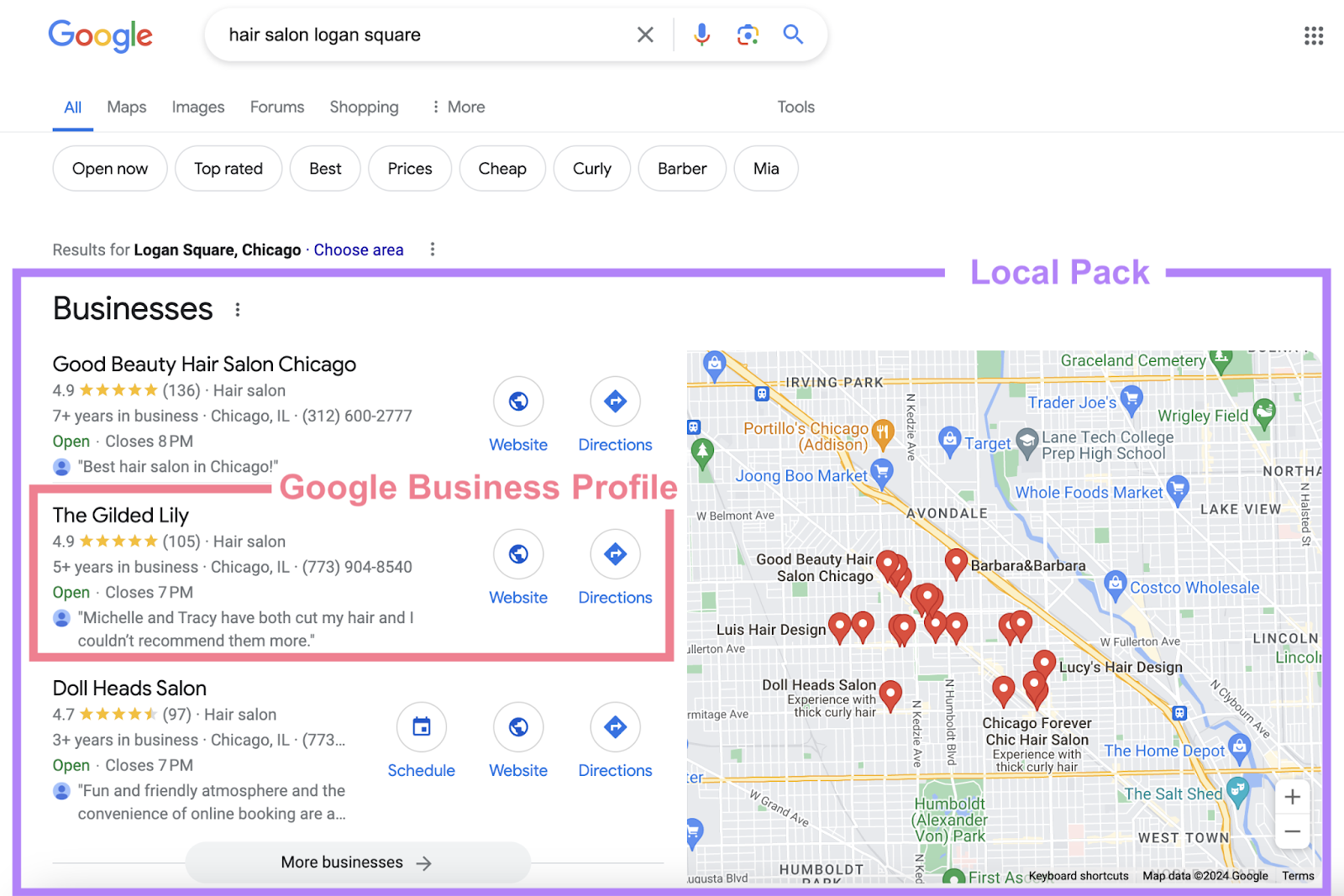
And boost your website’s rankings in standard “blue link” results.
Like this:
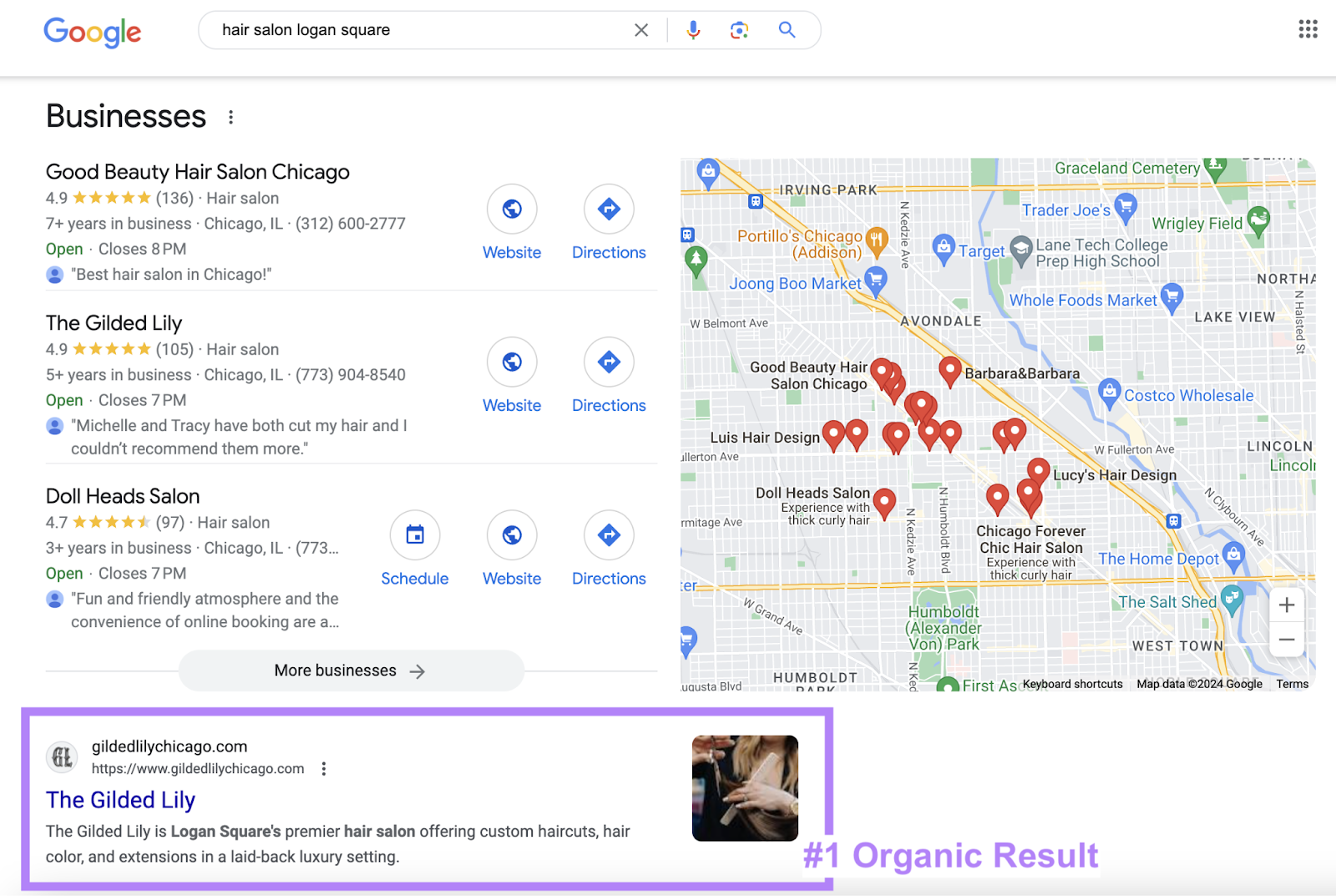
Almost all search results are personalized based on the user’s country. But local SEO is about reaching people in more specific locations, such as cities and districts.
So, it can benefit businesses with physical stores (restaurants, dentists, and mechanics, etc.). And local service providers (plumbers, tutors, and dog walkers, etc.).
Why Is Local SEO Important?
Google delivers billions of local search results every month. And if you appear prominently for relevant queries, you’re more likely to attract customers.
Google displays local results when it believes searchers are looking for products, services or amenities nearby. Or in a specified location.
Here are some examples of local keywords found with Semrush’s Keyword Magic Tool:
- “mexican restaurants”
- “mexican restaurants near me”
- “mexican restaurants in dallas”
Businesses with the best local SEO tend to rank highest for local keywords like the ones above. So, users are more likely to discover and engage with those companies.
No matter what your business is or where you’re located, it’s likely that you can reach potential customers through search.
How Local SEO Works
Local SEO works by helping Google understand where your business is located and what it offers. It can also help Google perceive your business as more popular and trustworthy.
All these factors can help you rank higher when people search relevant queries.
When ranking businesses in Google Maps and the local pack, Google considers three main criteria:
- Relevance: How well the business matches what the user is looking for
- Distance: How far the likely search location is from the business location
- Prominence: How well-known and well-reviewed the business is
When ranking webpages in traditional search results, Google considers factors like:
- Relevance: How well your webpage matches what the user is looking for
- Quality: How helpful and trustworthy your content is
- Usability: How strong your webpage’s performance is (based on things like speed and mobile-friendliness)
How to Do Local SEO
Now, it’s time to create a plan to increase your local rankings and boost traffic. The following steps will help you get started.
Do Local Keyword Research
Keyword research for local SEO is the process of finding search terms people use when searching for local products and services.
Ranking for these keywords drives highly targeted local traffic to your site and sends more customers your way.
To get started, you need a short list of keywords people can use to find your local business.
Here are a few different ways to start.
Research Your Competitors
Seeing what keywords your competitors rank for is an easy way to start gathering ideas. And you can do that with Semrush’s Keyword Gap tool.
Enter your domain and up to four competitors’ domains. (The tool will provide suggestions to help you.)
Then, choose your target country and click “Compare.”
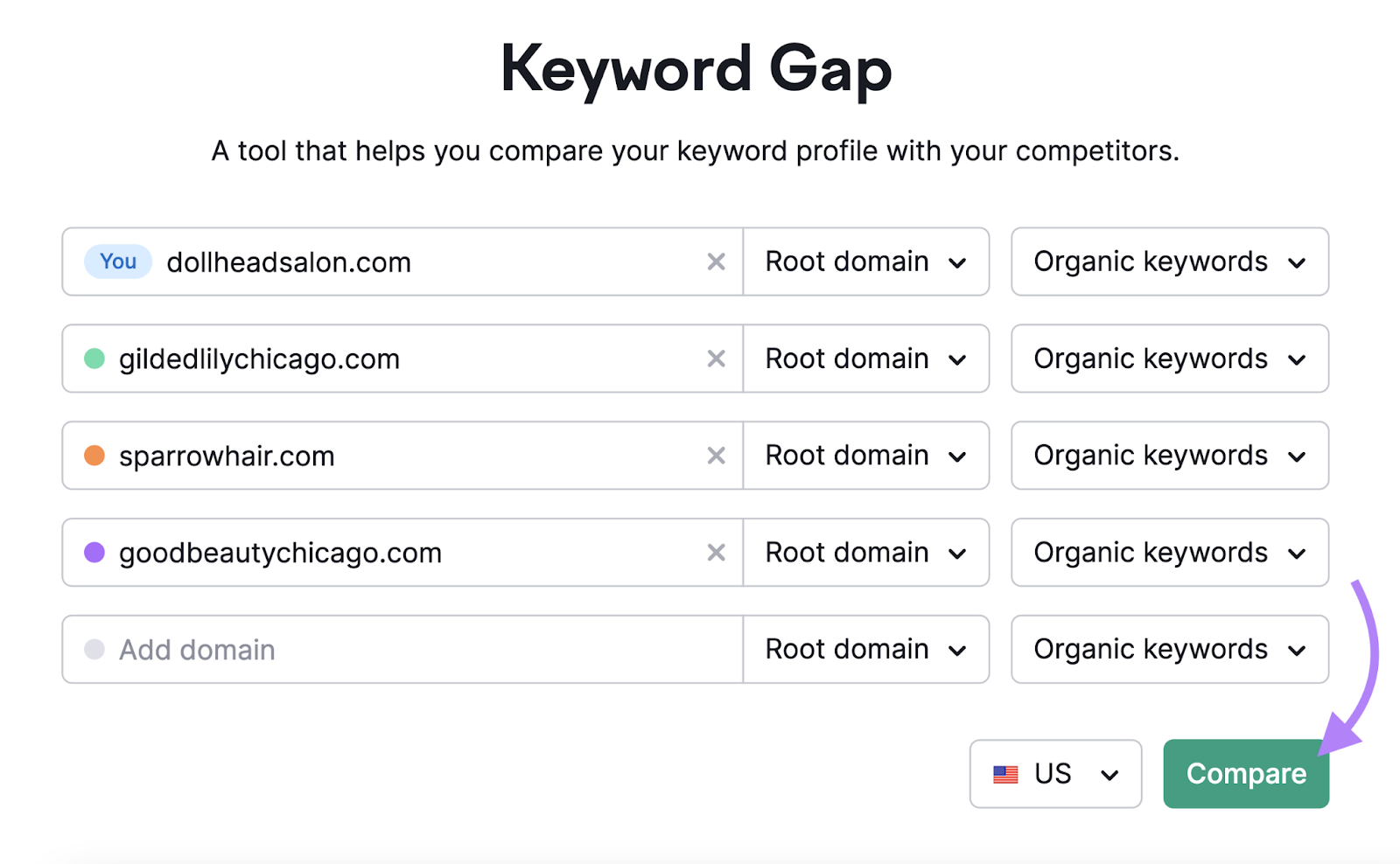
Scroll down to the keyword table and select “Untapped.”
You’ll see keywords that at least one competitor ranks for but you don’t. So, these could be relevant terms that you’re missing out on.
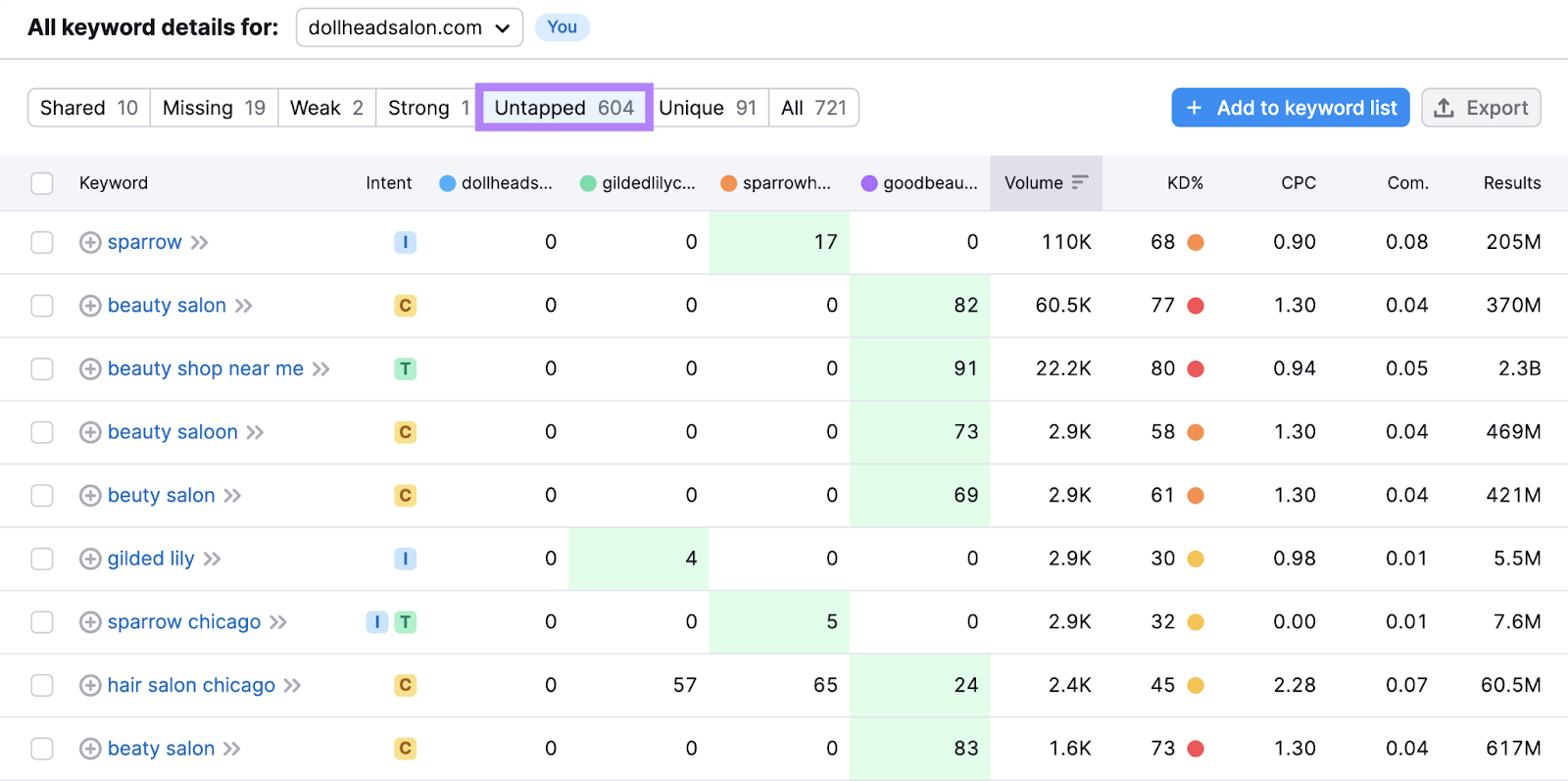
Click “Advanced filters” to exclude any irrelevant keywords (e.g., keywords that contain your competitors’ business names).
Like this:

You can also filter based on metrics like:
- Volume: The keyword search volume (average number of monthly searches)
- KD%: The keyword difficulty score, which measures how hard it’ll be to earn a high organic ranking and is expressed as a percentage
- Intent: The general purpose behind the search, which can be transactional, commercial, navigational, and/or informational
This makes it easier to spot the best keywords for your local SEO strategy.
Use Google Autocomplete
Google autocomplete is a feature within Google Search that makes it faster to complete searches when you start to type.
Its purpose is to save users time by predicting what they’re going to search for.
And it can help you discover valuable long-tail keywords for local SEO. Because Google’s autocomplete predictions depend partly on your location.
For example, if you’re in Arcadia, California, you’ll see something like this if you type “best paella in” into the search bar:
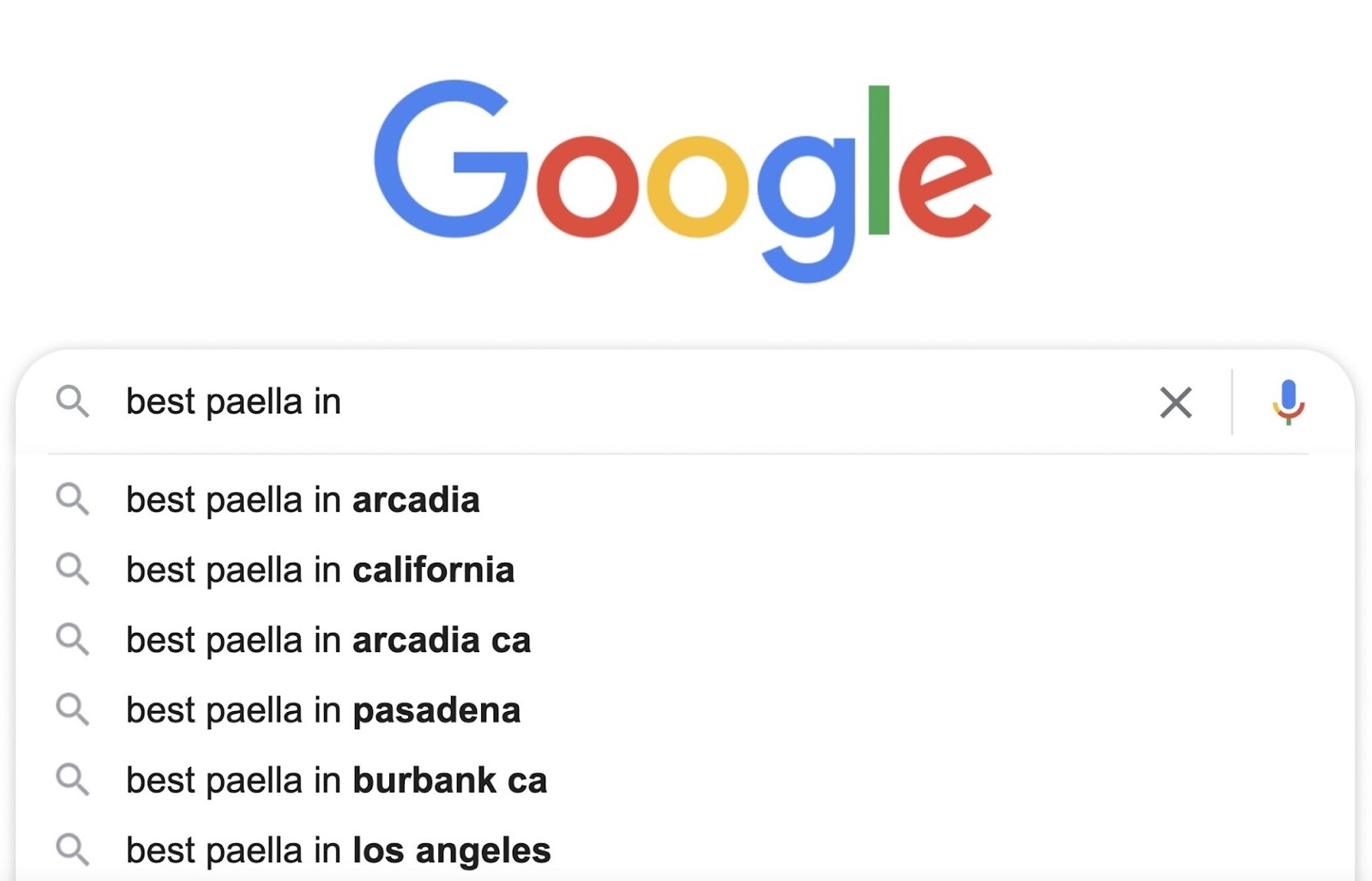
All these locations are near Arcadia or in California.
So, to find valuable local keywords, start typing in keywords related to your business.
For example, if you run a cleaning service business, type in “cleaning services” to get a list of local keyword suggestions.
Like this:
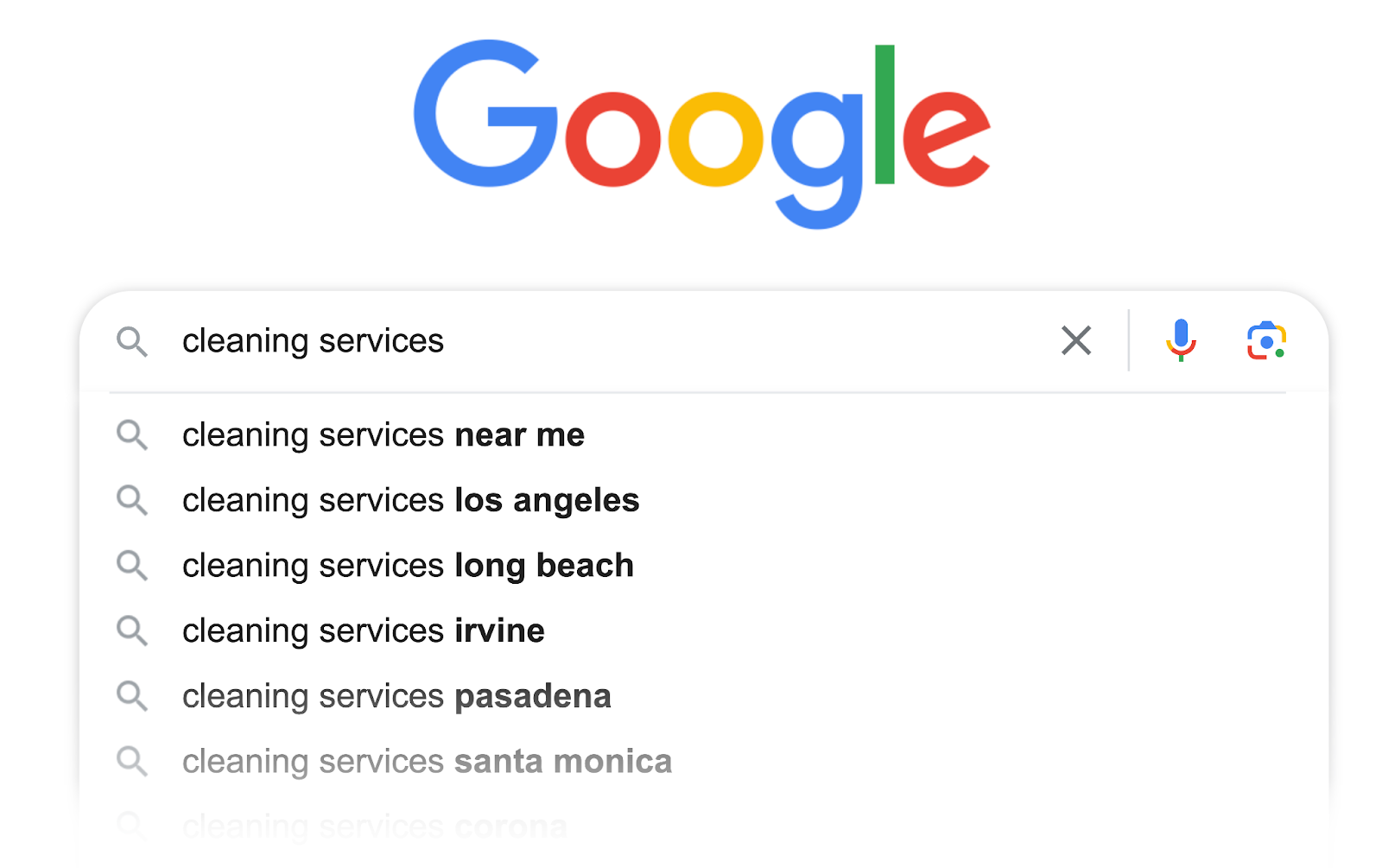
And when you start adding local modifiers like “cleaning services los angeles,” you start to see lots of other useful keywords.
Like this:
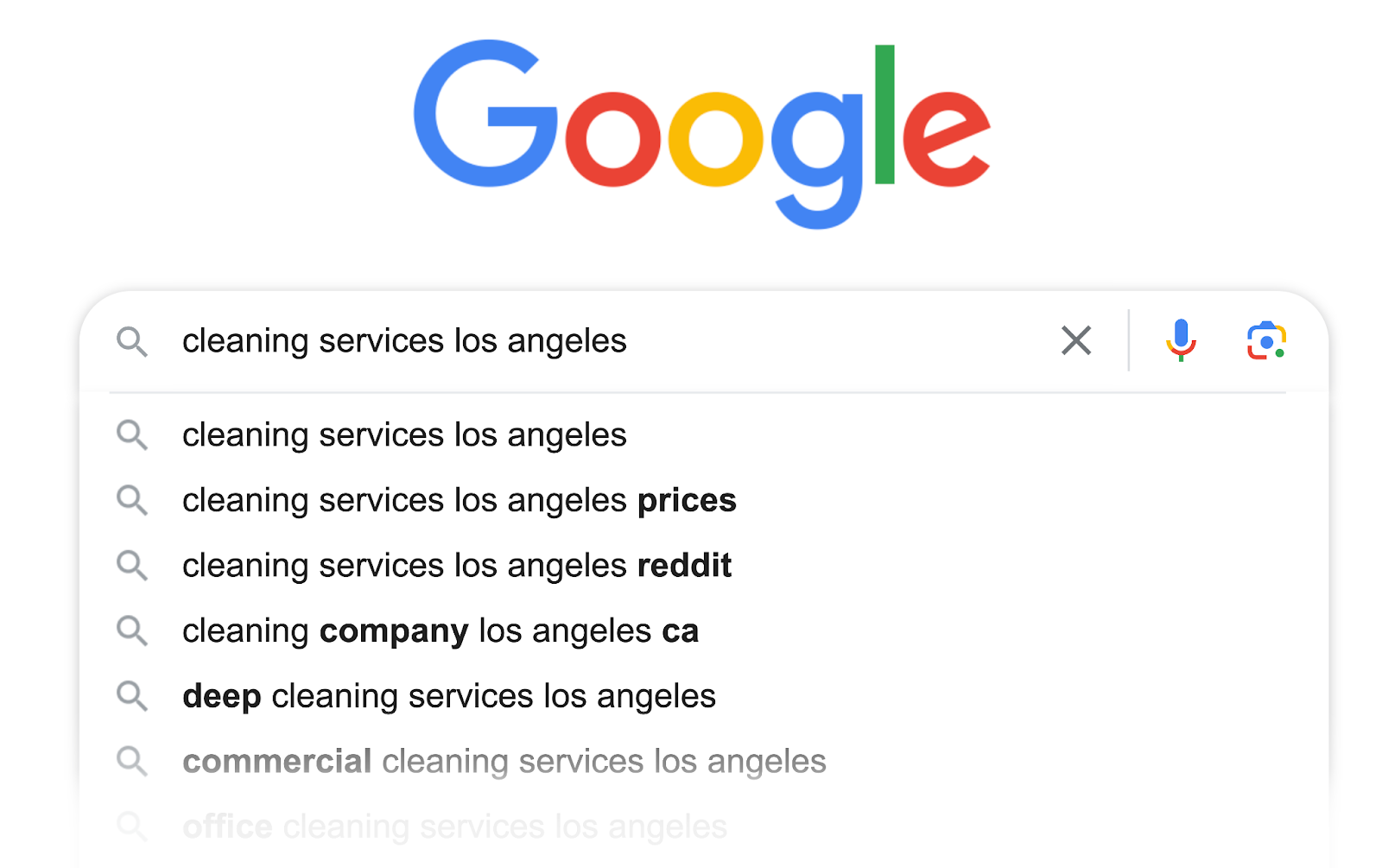
Keep trying new combinations of different local keywords. You should have a list of keywords for your local business SEO in no time.
Leverage Google Keyword Planner
Google’s Keyword Planner helps you research keywords for paid search campaigns.
But it’s also great for discovering new keywords related to your business.
Start by going to the “Discover new keywords” section.
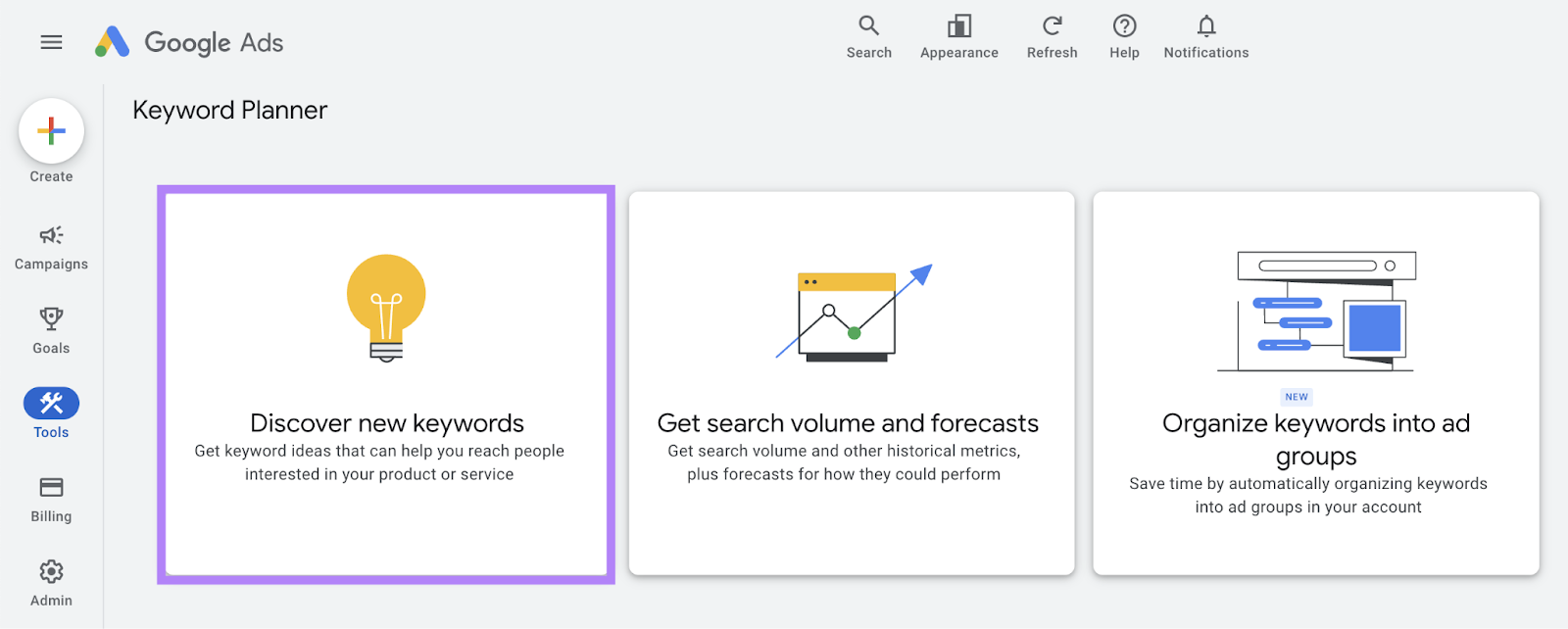
Click on the “Start with a website” tab. Then, enter one of your competitors’ domains.
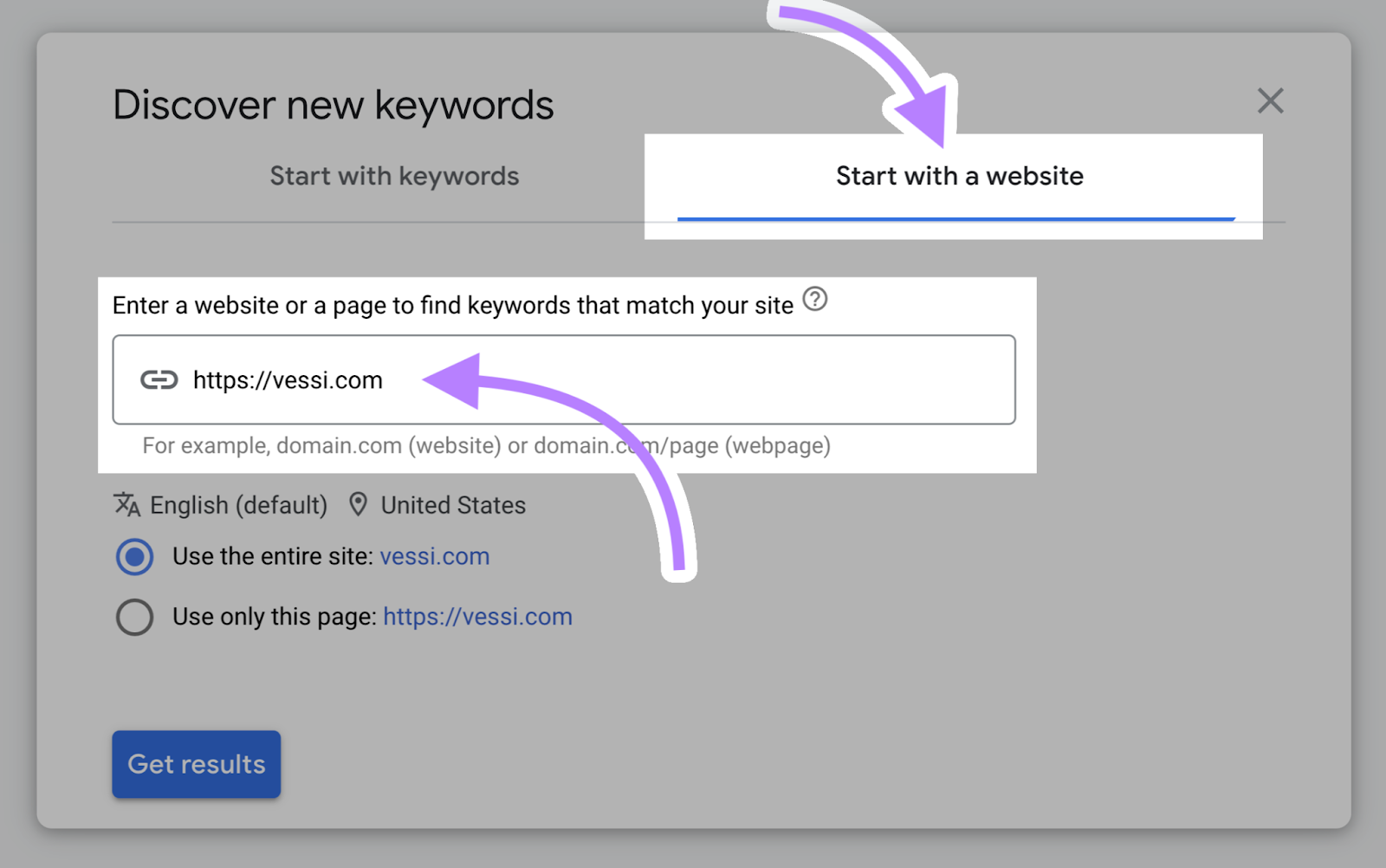
Click “Get results,” and Google will suggest a ton of keywords based on the terms that appear on that website.
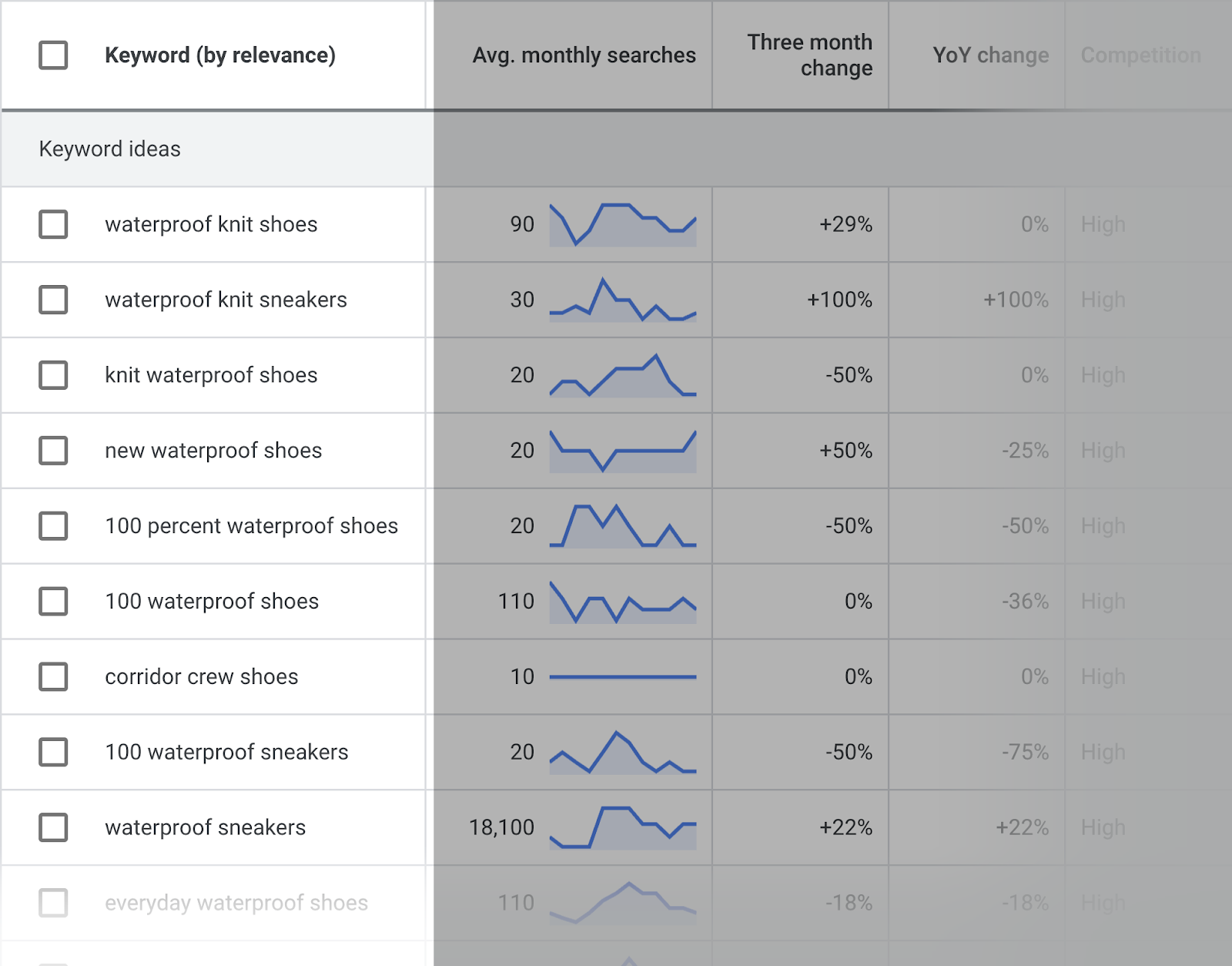
Repeat the process with more of your top competitors and add all the relevant keywords to your list.
Another great Keyword Planner feature: It gives monthly search data for specific locations.
Like so:

This feature is really helpful when you have lots of keywords and want to decide which to target first.
Optimize Your Google Business Profile
Your Google Business Profile is the free business listing that can appear in Google results.
Like this:
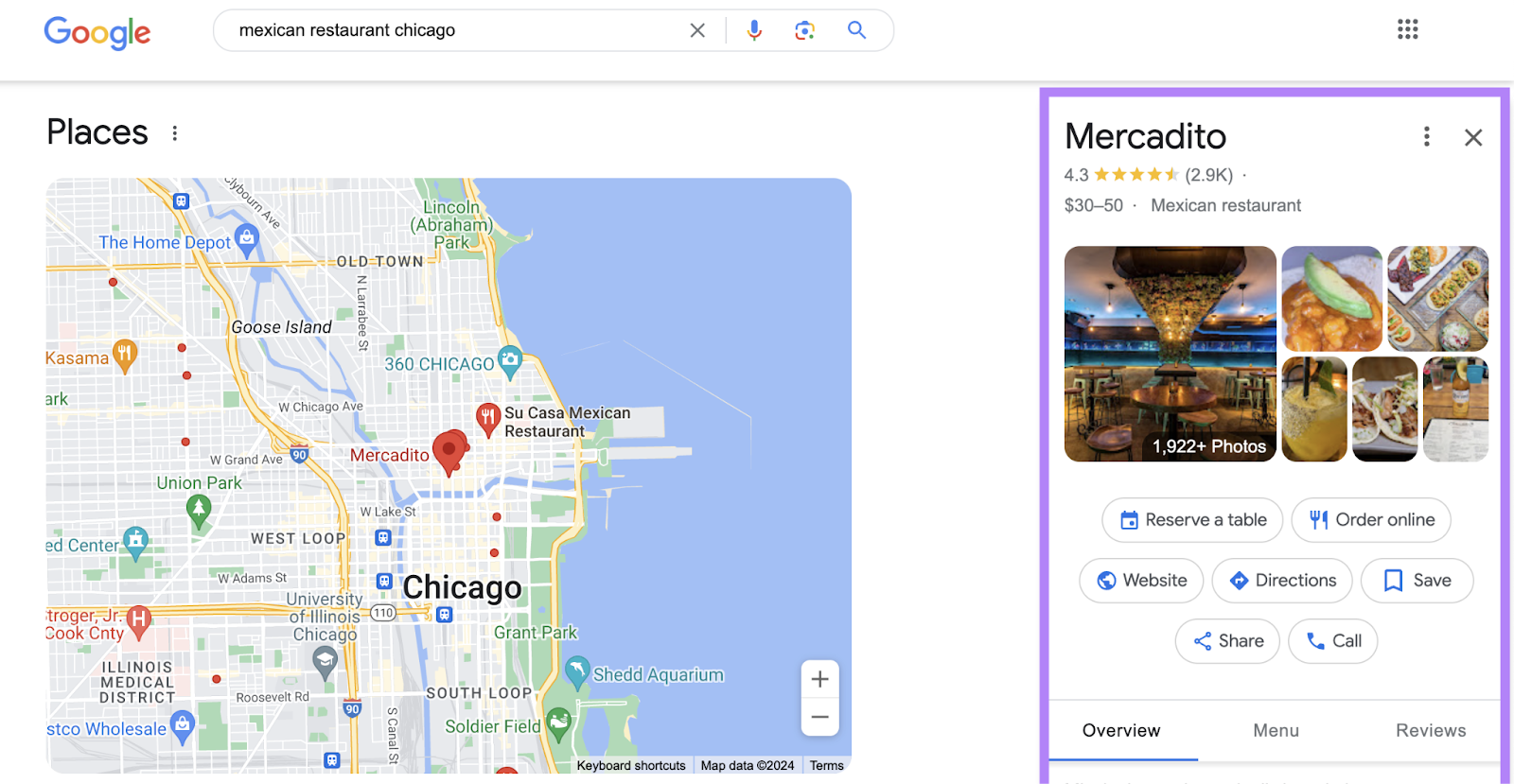
If you optimize your profile, Google is more likely to rank it highly when prospective customers search for relevant terms. Which means those users are more likely to contact or visit your business.
To get started, you’ll need to add and/or verify your Business Profile. And fill it out as much as possible.
For example, you can provide:
- Contact details
- Opening hours
- Photos and videos
- Business attributes (e.g., Wi-Fi and outdoor seating)
Keep Your Business Profile Active
Keeping your Business Profile active shows Google and users that you’re an engaged business owner. This can help you get higher rankings and more customers.
Most importantly, keep your business details up to date (e.g., add your holiday hours or change your address the moment you move to a new location).
This ensures users always have access to correct and comprehensive information.
Also consider posting on your Business Profile. To inform users about your latest news, events, and offers.
With Semrush Social, you can easily schedule your posts:
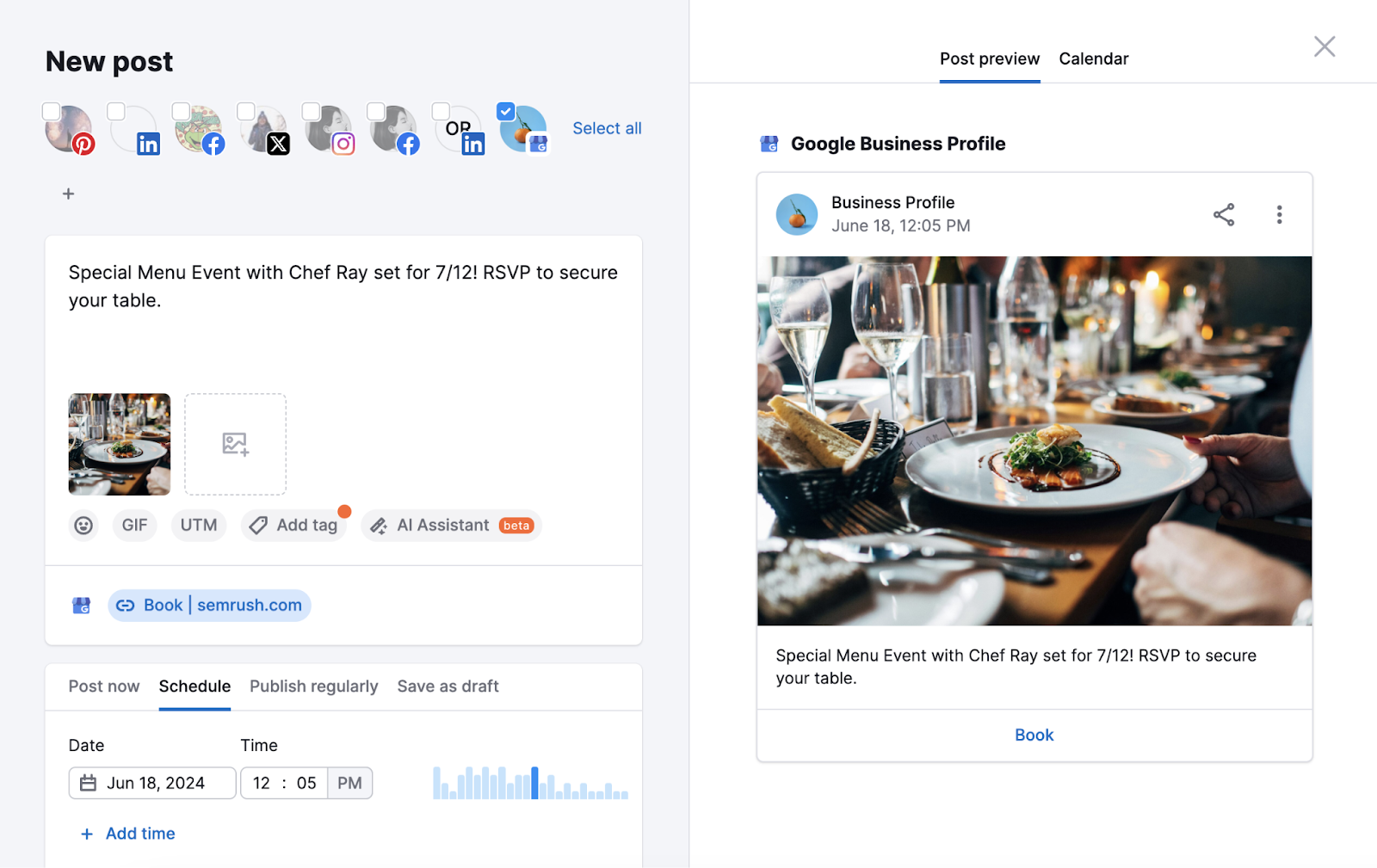
It’s also a good idea to ask customers for Google reviews.
If you have more reviews and a higher star rating than your competitors, you stand a better chance of outranking them. And users may be more likely to choose you.
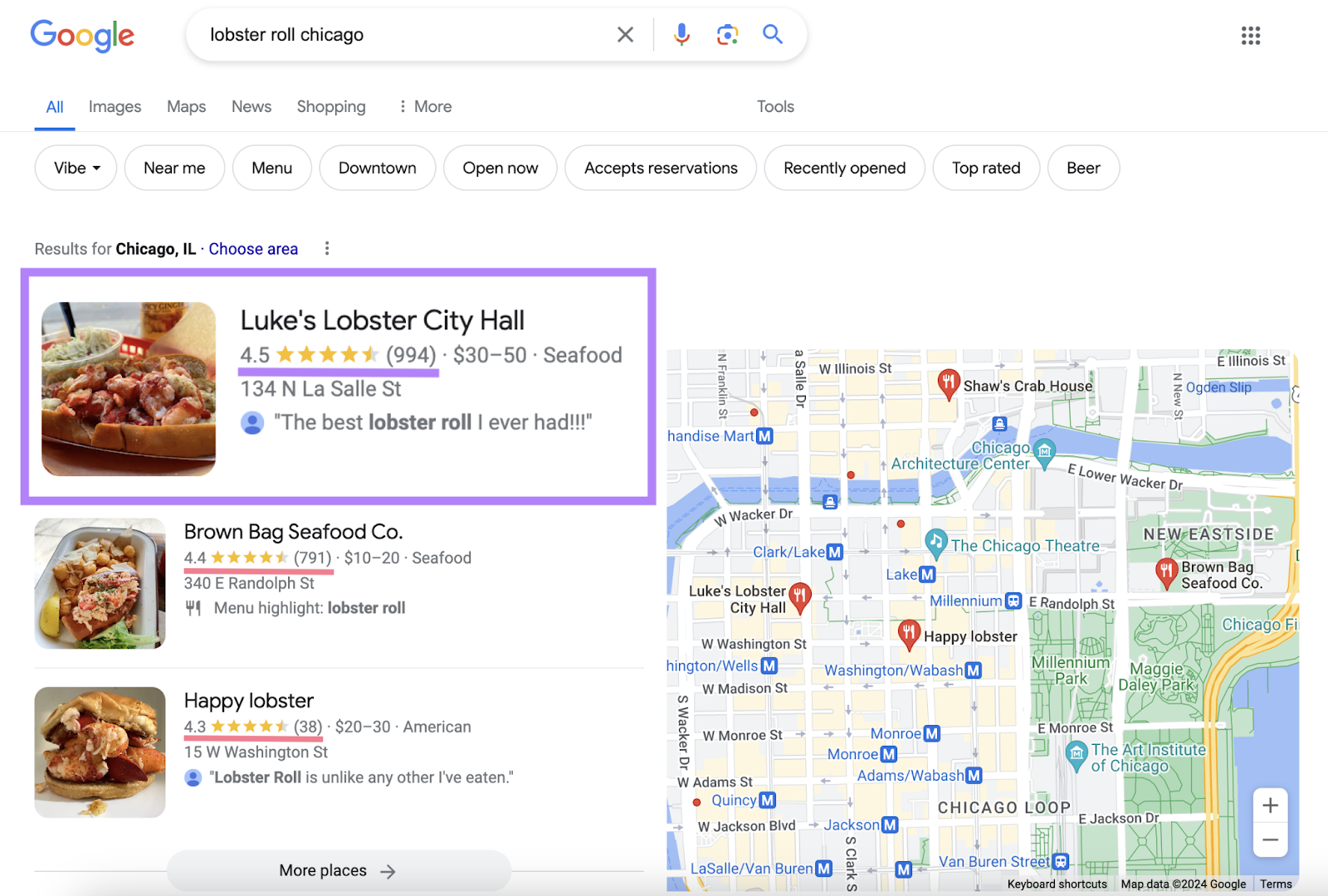
Respond to your Google reviews, too.
This shows that you care about your customers’ feedback. And gives you the opportunity to counter any negative comments.
With Semrush’s Review Management tool, you can set up automatic replies using AI.
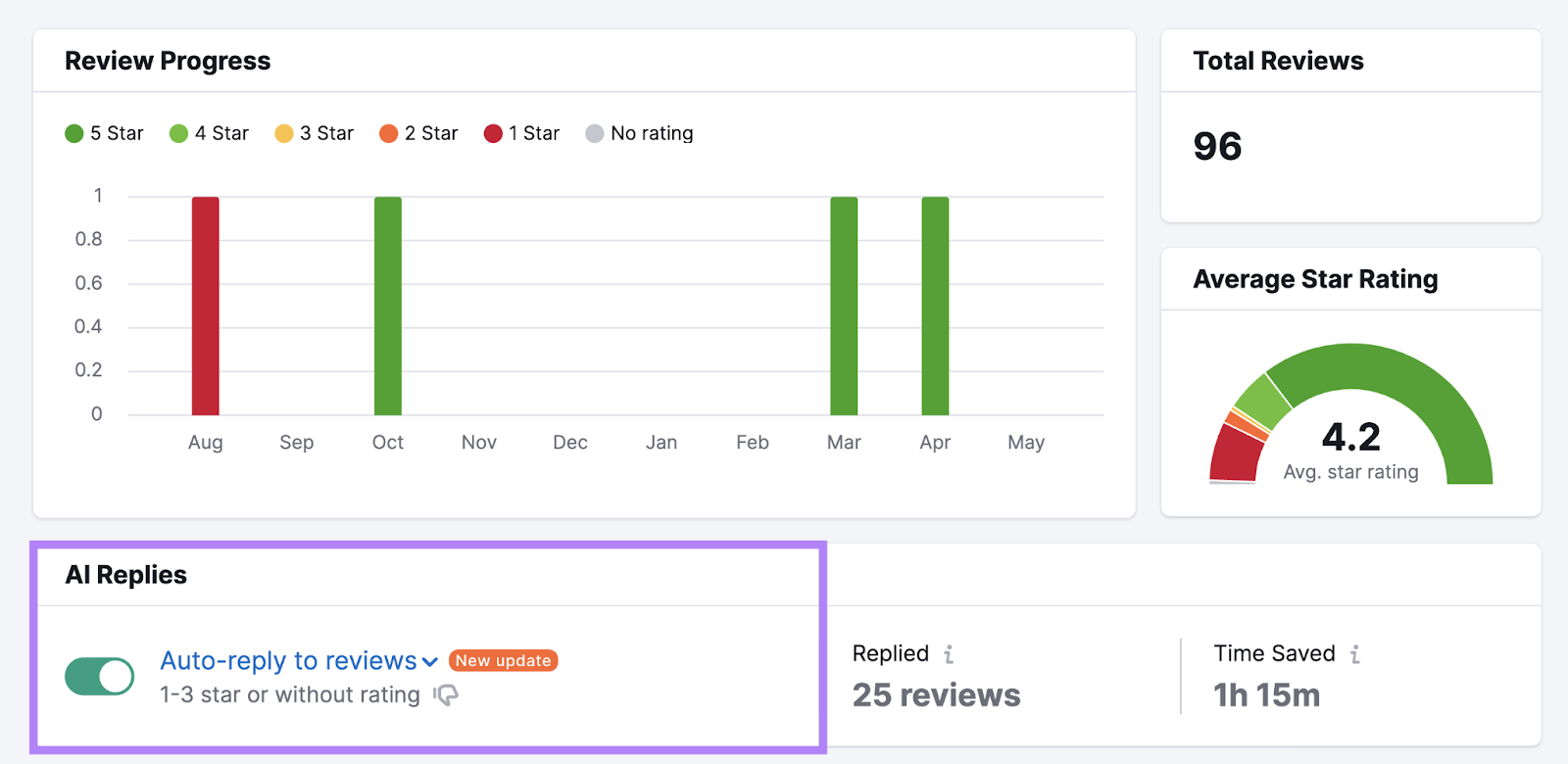
Get and Monitor Local Citations
Citations are places that mention your name, address, and phone number (NAP) online.
They usually appear on business directories and social media profiles.
NAP citations are important because Google may use them to verify that your business information is accurate. And that what you say about your business online is true.
Like this:
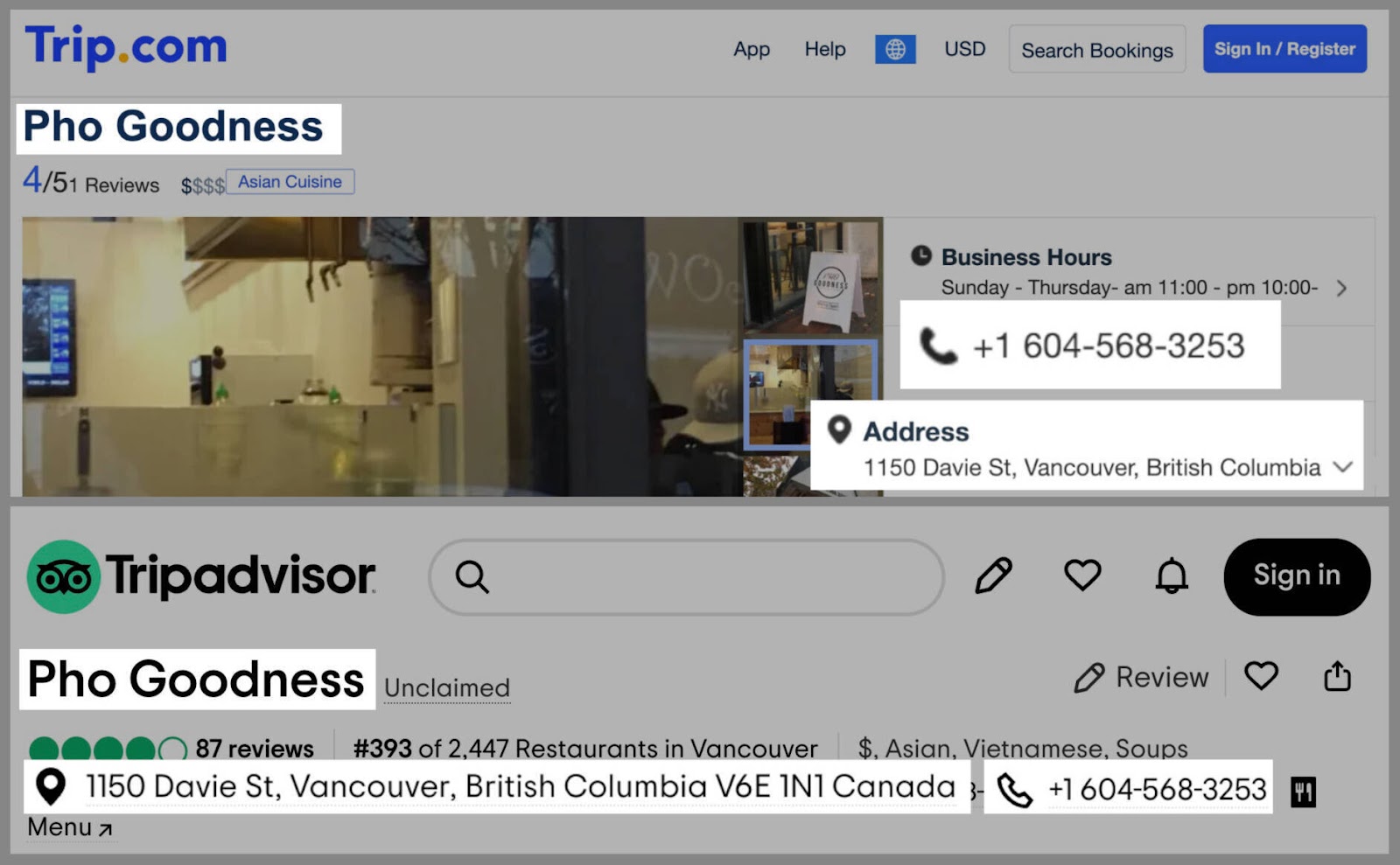
The idea is that the more Google sees consistent NAP citations for your business, the more confident it is that your business is legitimate and trustworthy.
So, you want to get consistent citations on as many trusted websites as you can.
An easy way to check your local listings and distribute them to the most authoritative directories is to use Semrush’s Listing Management tool.
To get started, enter your company name. And choose the company with the correct address from the list that appears.
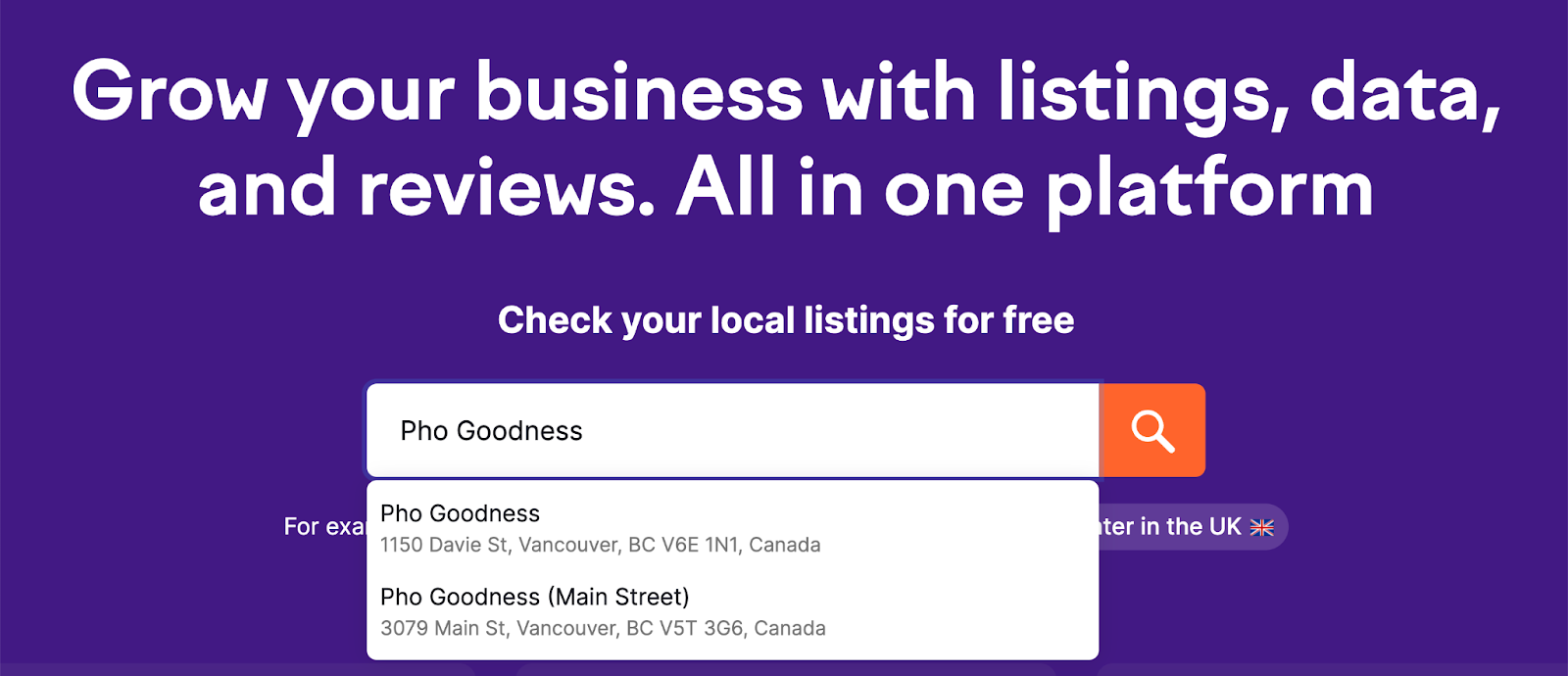
You’ll see a report of your current online presence.
Including the total number of listings, listings to fix, and average star rating.
Like this:
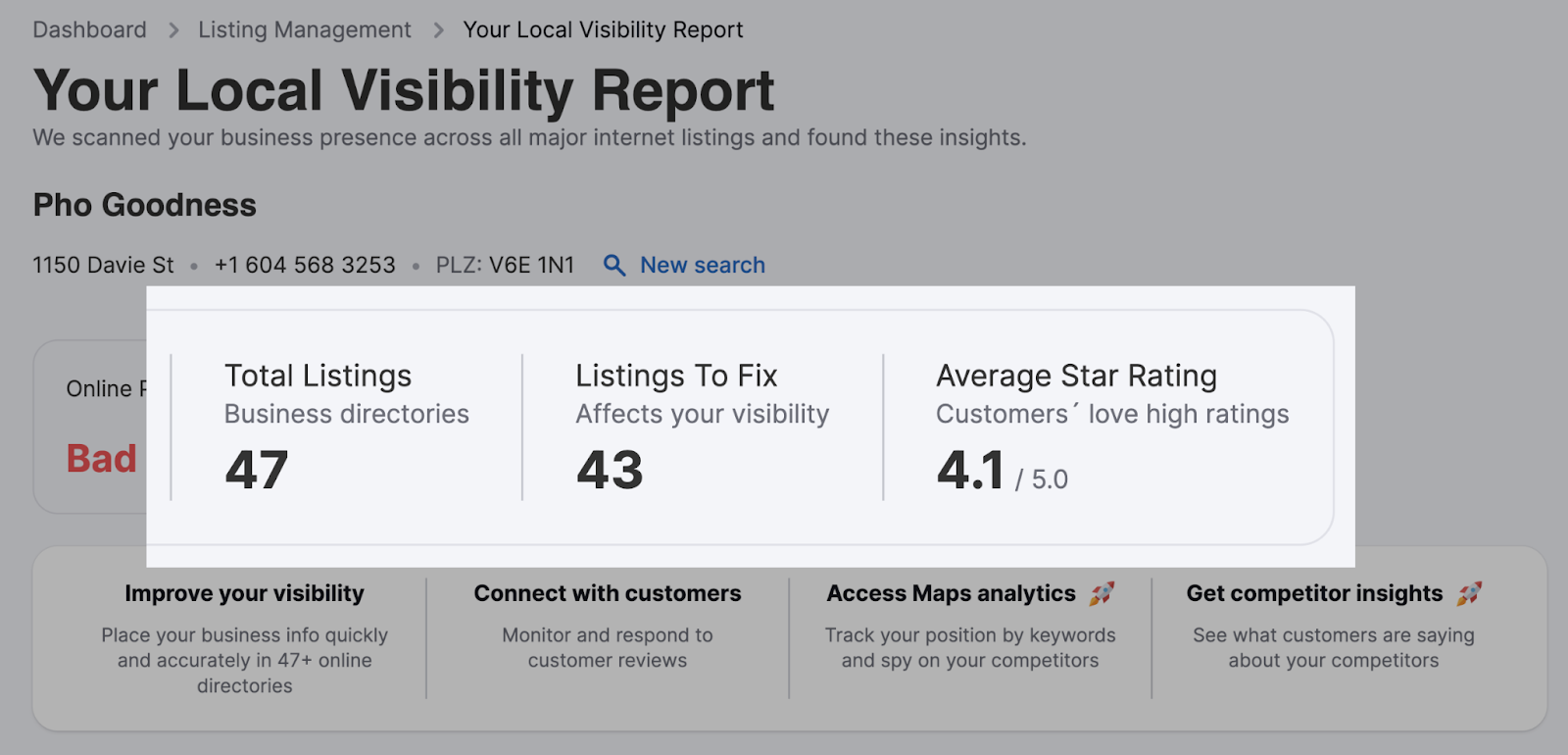
The tool also has a list of your citations with specific errors (e.g., wrong phone number, wrong address, etc.).
Simply scroll down to find it.
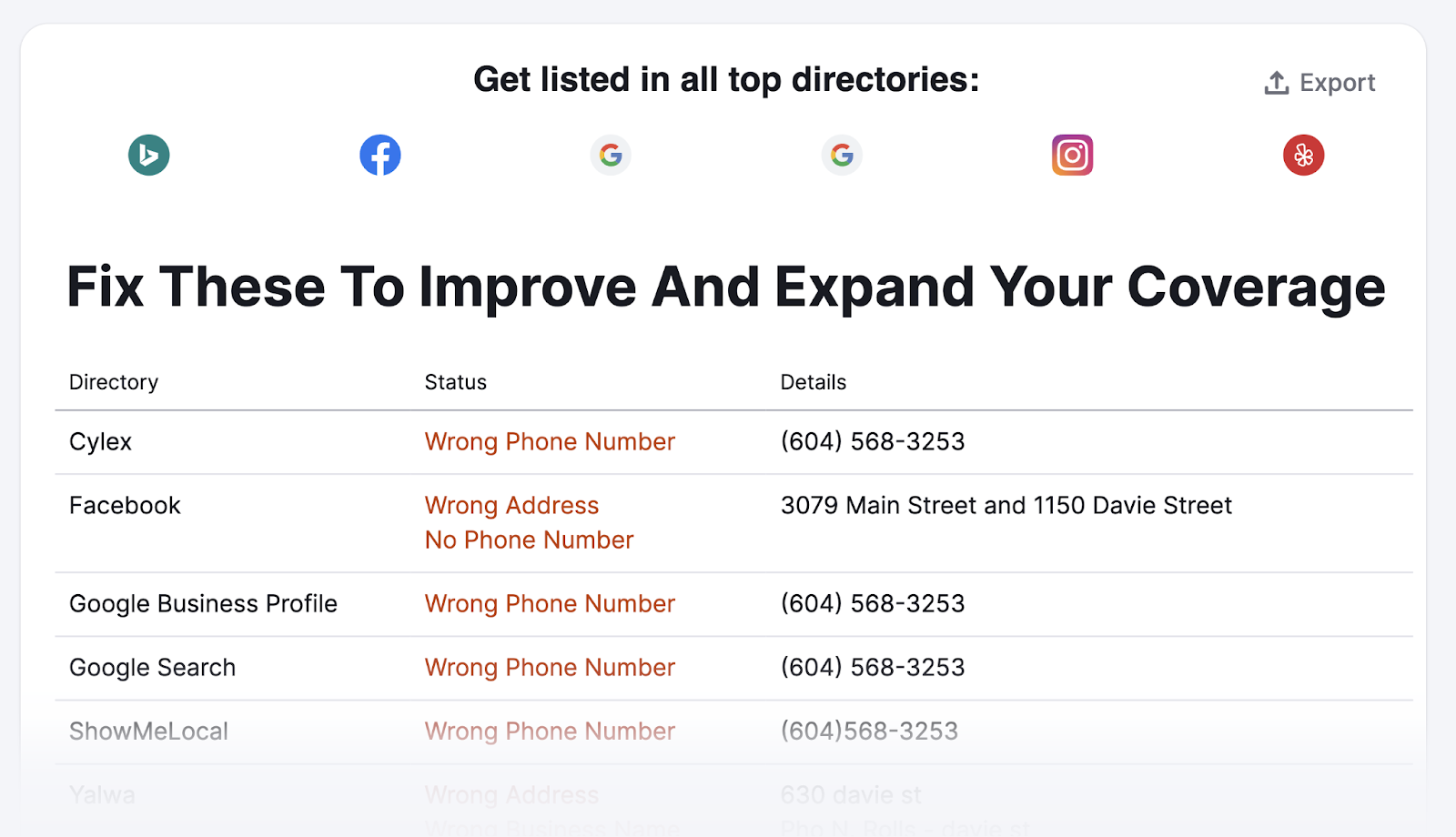
You can then download all of this information using the "Export" button in the top right corner of the list.
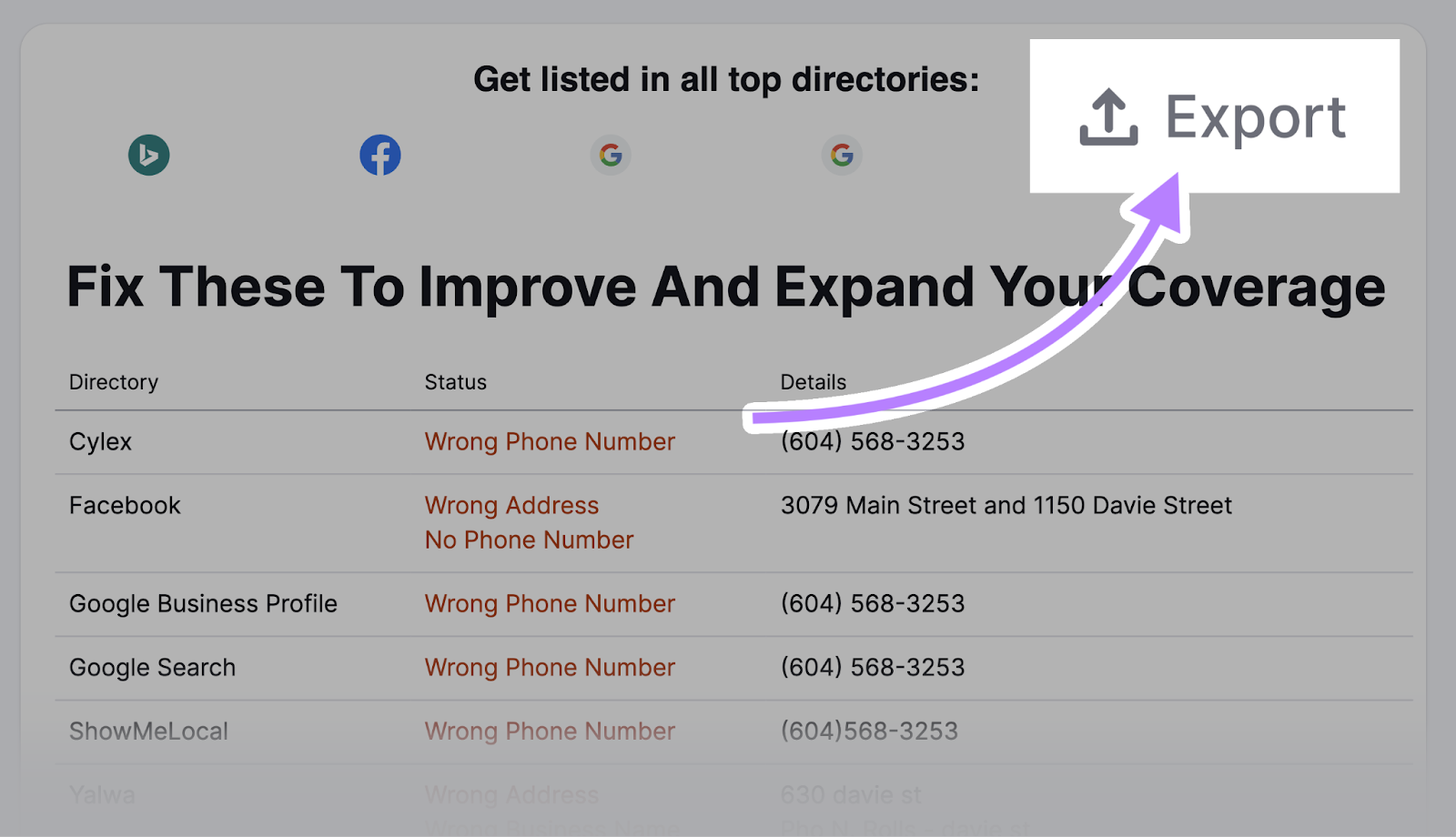
If you have a paid subscription, you can automatically distribute your business information to dozens of directories.
First, make sure your listing is up to date.
If you need to change anything, click the “Edit business info” button.
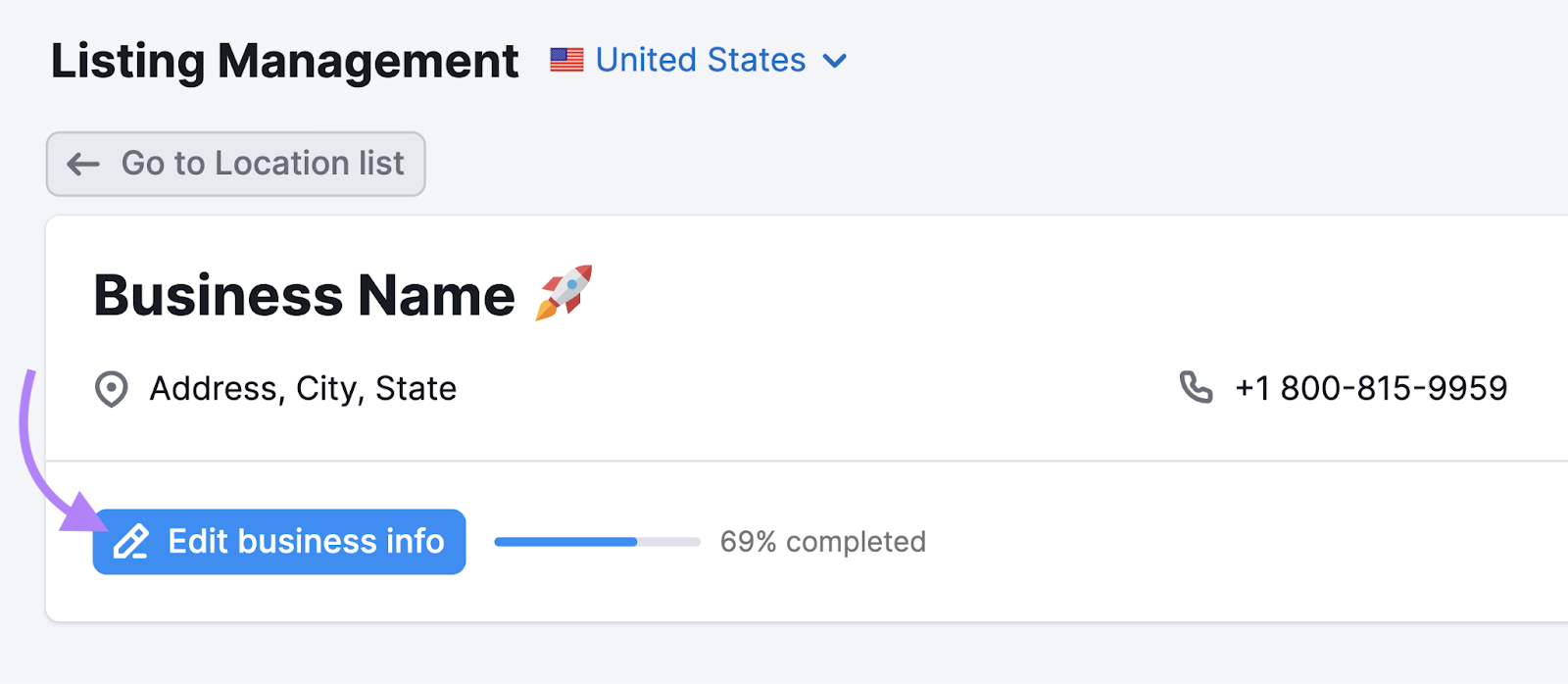
Then, add additional information like photos, videos, your Google Business Profile cover photo, social media handles, and more.
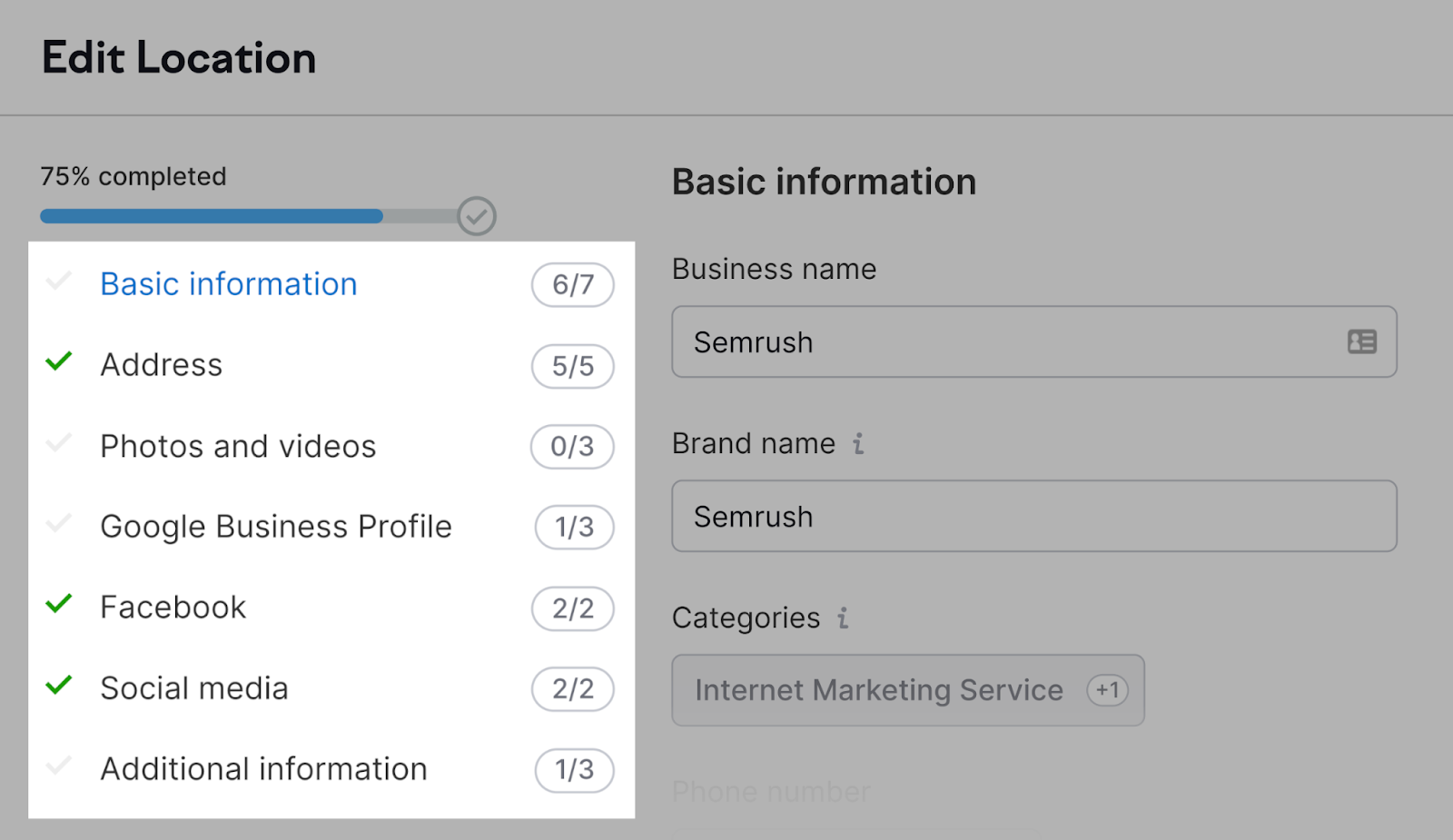
Following that, you’ll see a dashboard with seven tabs:
- Your listings (view of all your listings and their current statuses)
- Insights of GBP (see a dashboard that consolidates data from your GBP analytics account)
- Duplicates (see all possible, processed, or removed duplicate listings)
- User Suggestions (approve or reject customer-suggested changes)
- Review Management (monitor and respond to reviews and ratings for all your locations)
- Review Analytics (keep track of your competitors’ reviews and compare them to yours)
- Local Rankings (see how well your business ranks for any city location)
It looks like this:

Make sure all your information is updated and as detailed as possible.
Then, let the tool carry the heavy load of automatically keeping your NAP citations consistent everywhere.
Here are a few NAP citation tips:
- Keep all of your citations 100% consistent (exact same name, address, phone number)
- Submit your information to popular directories in your local area and industry
- Submit to big players (like Apple Maps, Yelp, Bing Places, Facebook, etc.)
Encourage and Respond to Online Reviews
Reviews provide social proof, validate your expertise, and give potential buyers confidence in your business.
Generally, you should try to get reviews on Google. Because they’re visible in search results and an important local ranking factor.
But if customers like to use other platforms (e.g., Tripadvisor), it’s helpful to get reviews there too.
Here are some quick tips for success:
- When you speak to happy customers, ask them to leave a review on your preferred platform(s)
- Create posters, business cards, etc. that encourage customers to leave online reviews. Making sure to include a QR code that makes it easy for them to find the right page.
- Embed widgets on your website that make it easy for visitors to see and leave reviews
- Don’t offer or accept money in exchange for reviews (it’s against terms for Google and many other platforms)
With Semrush’s Review Management tool, you can track your reviews across multiple platforms.
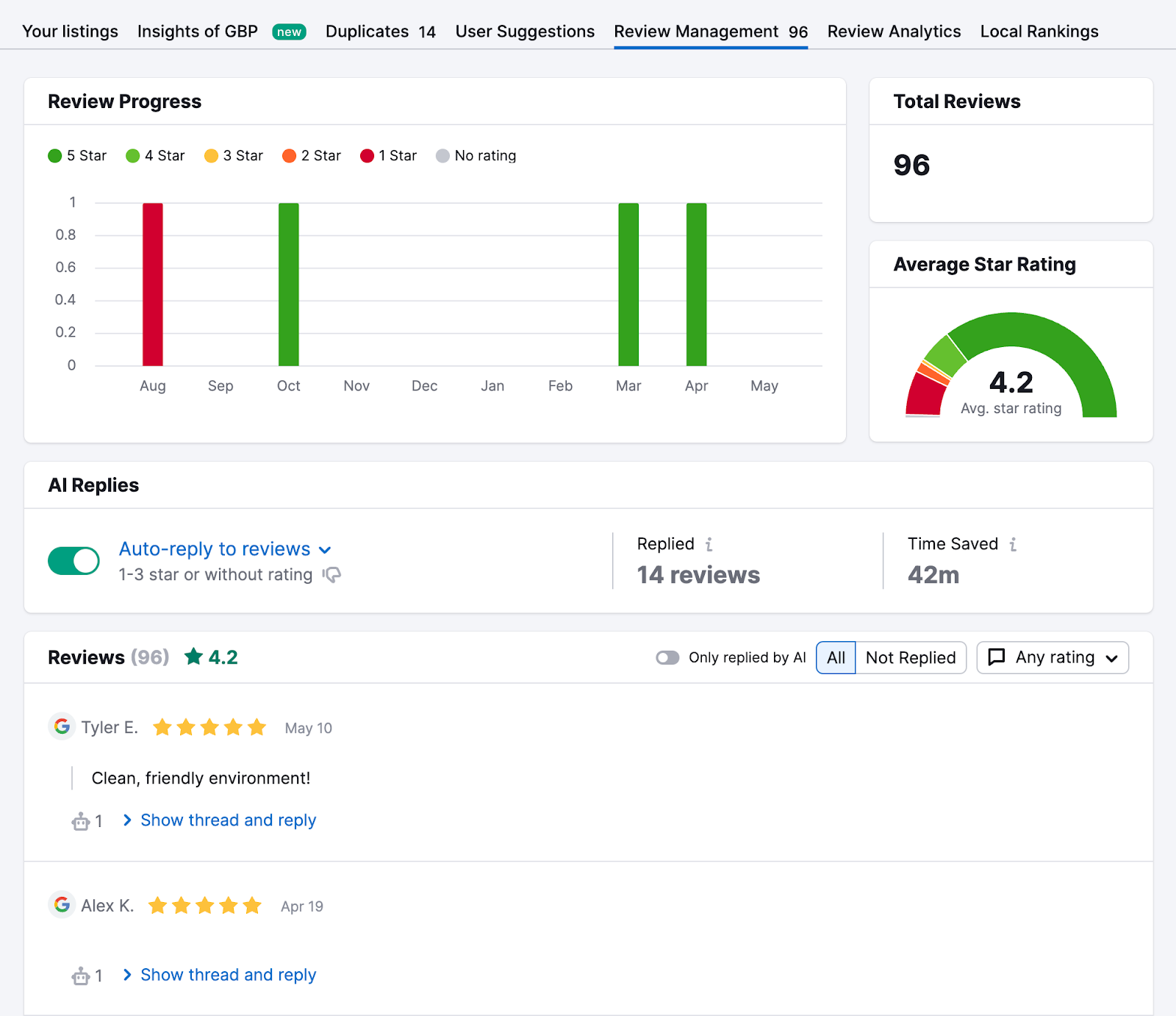
And every week, you’ll get an email alert about any negative reviews. So you can respond to them quickly.
Refine Your On-Page SEO
On-page SEO is the practice of optimizing your webpages to help them rank higher on organic search results. And it’s indispensable for local search engine marketing.
If you rank well organically, you likely have strong chances of ranking in the local pack.
To run a quick audit and gauge your on-page SEO health, use Semrush’s On Page SEO Checker.
Enter your domain and hit “Get ideas.”
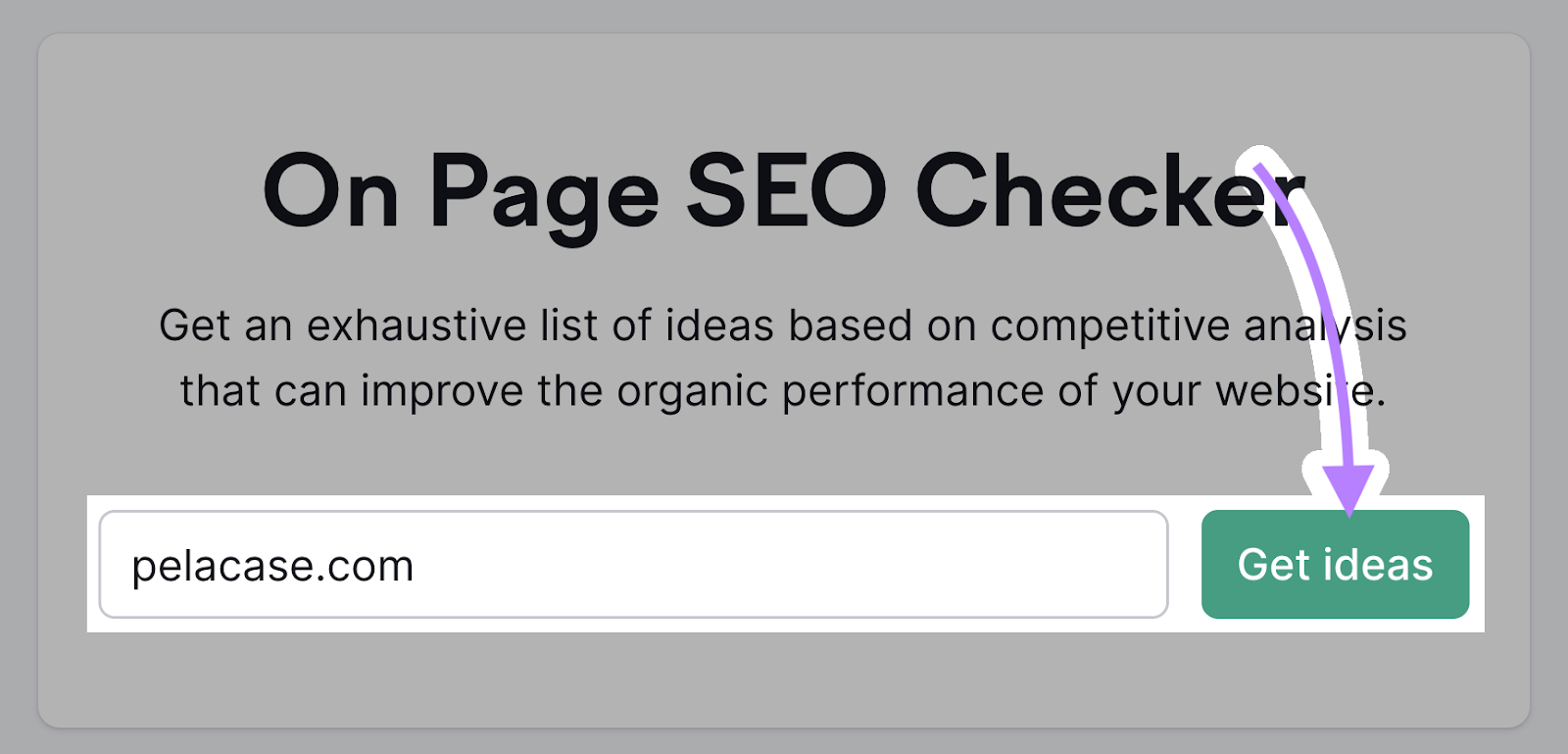
Follow the On Page SEO Checker configuration guide to set up your project, and the tool will automatically start running an audit.
After a few minutes, it’ll display a dashboard with different on-page factors for you to optimize.
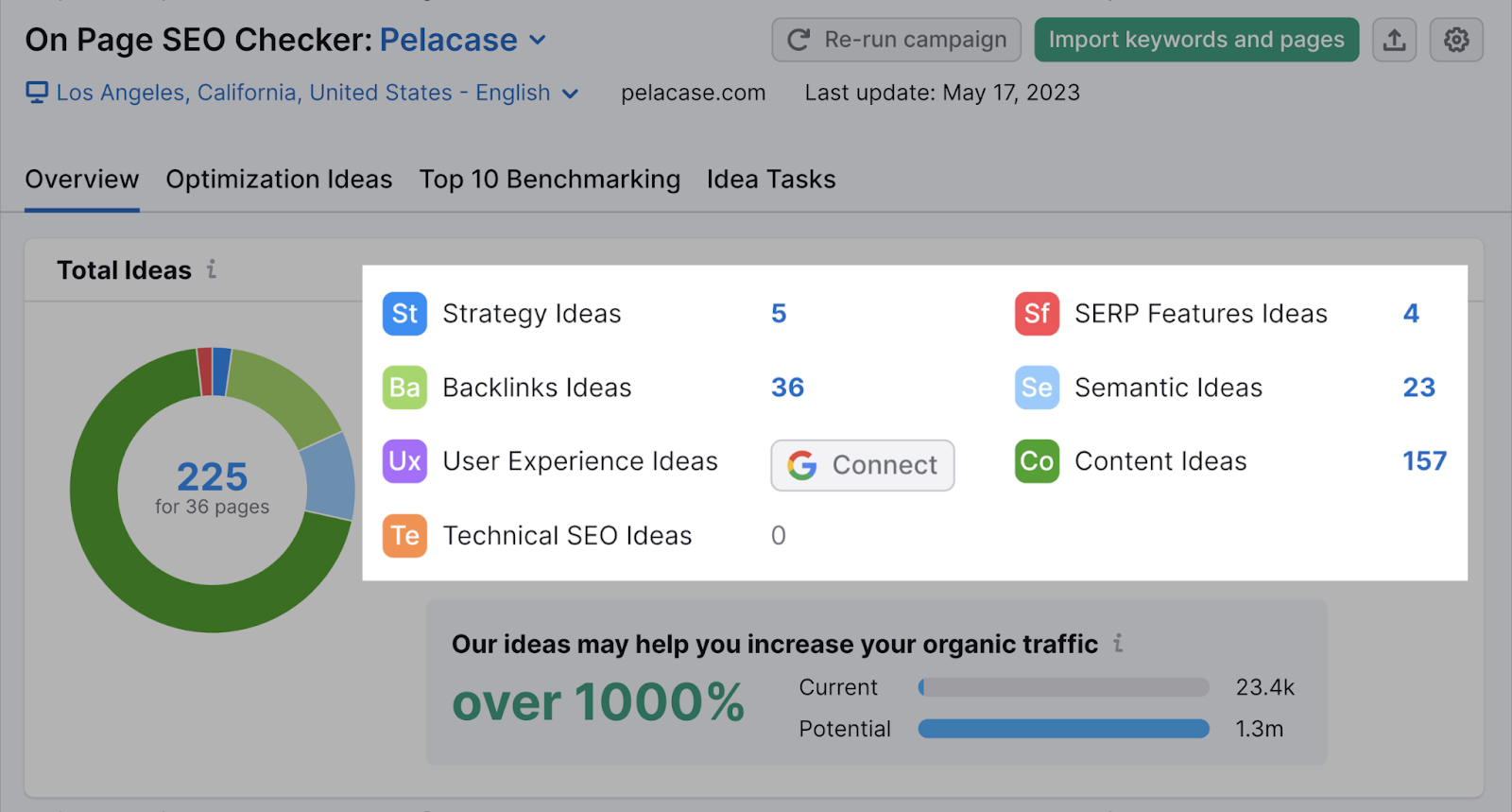
If you scroll down, you’ll see your pages are conveniently sorted by “Priority.”
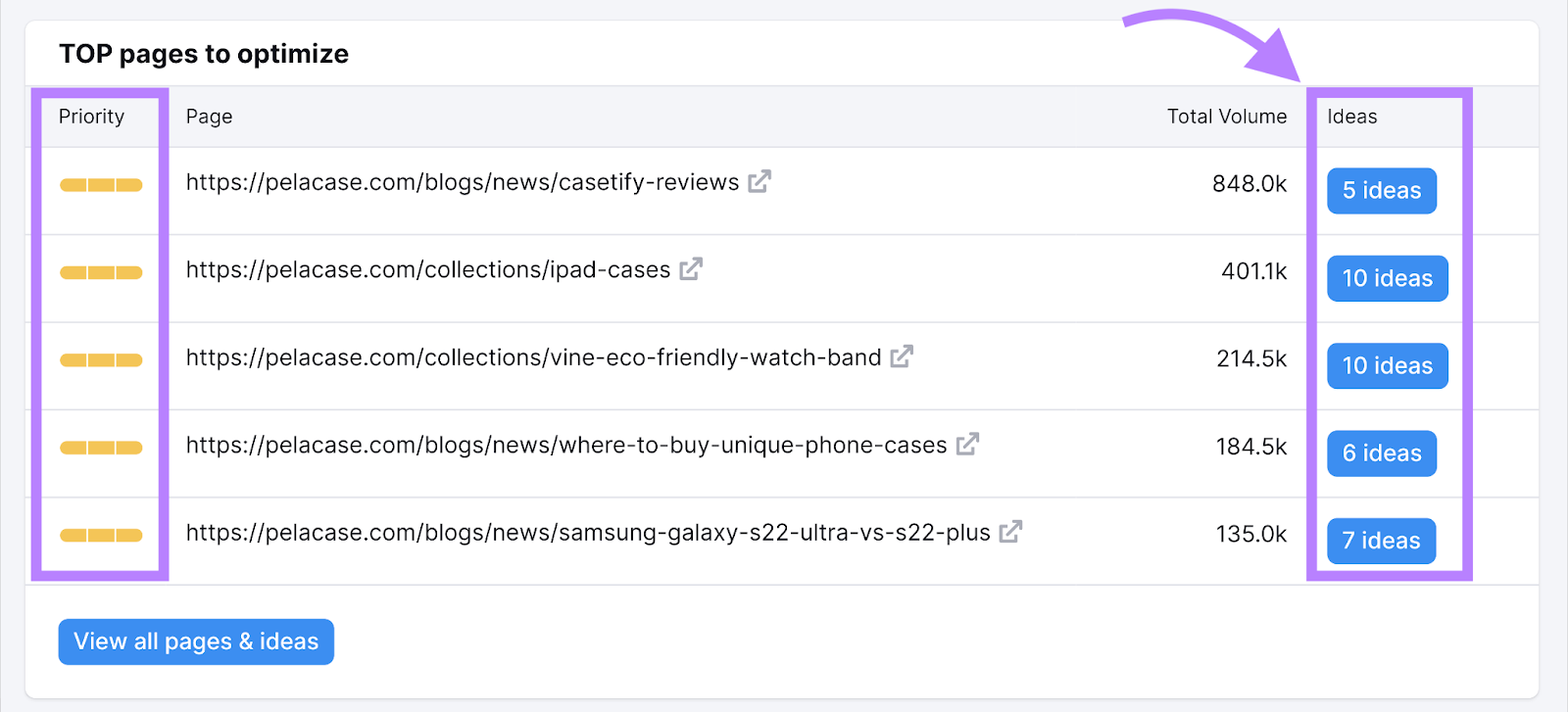
Optimize these pages first to get the most impactful results.
Click on the “# ideas” button beside each of the top pages to get more specific optimization ideas.
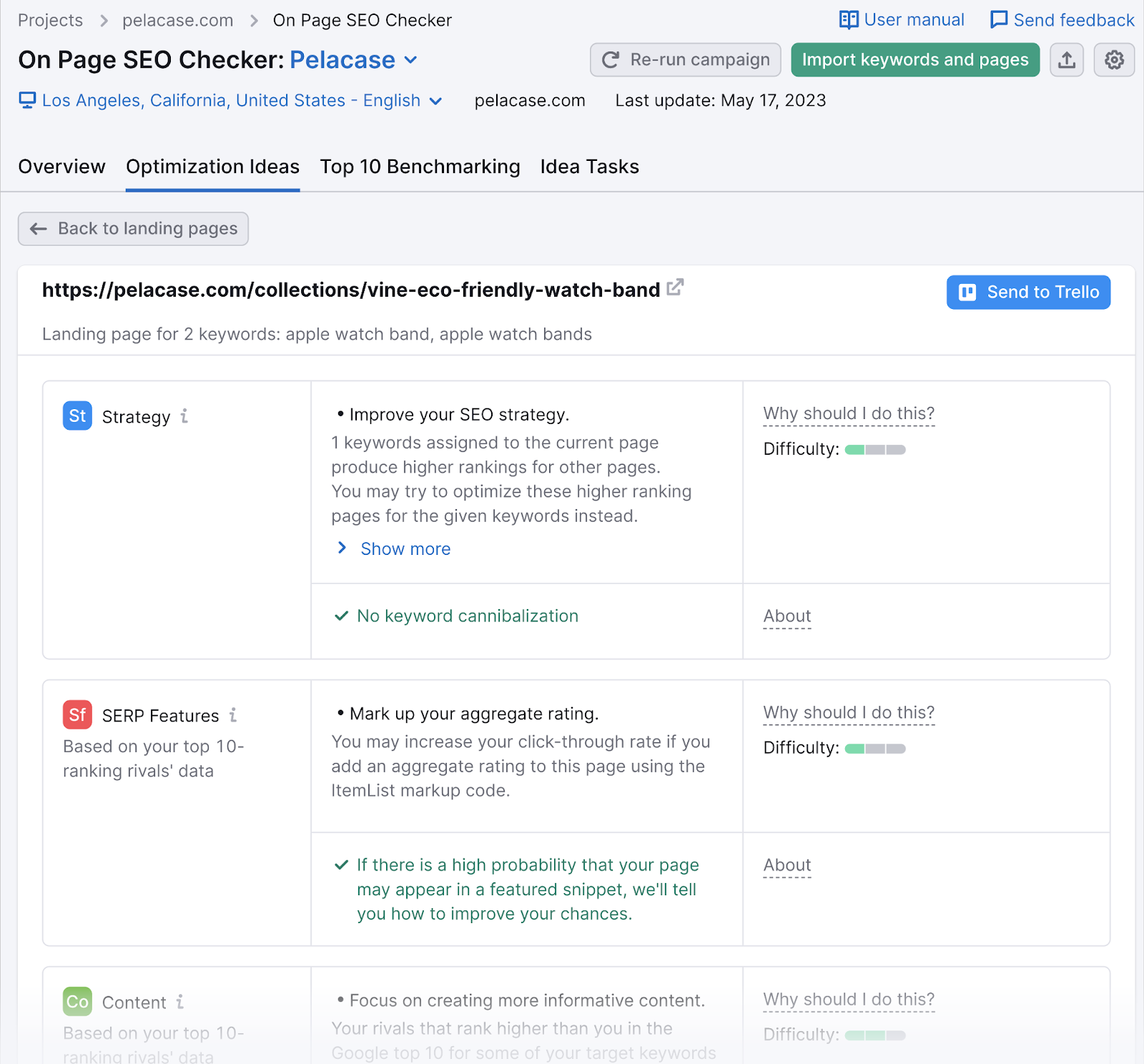
Here are a few on-page SEO tips:
- Include your locally targeted keywords in page title tags and meta descriptions
- Add specific location pages to your website to emphasize your local services
- Internally link to and from pages where relevant
Further reading: Local SEO for Multiple Locations
Build Backlinks
Backlinks are links on other sites that link back to yours. And are a strong ranking signal in Google’s search algorithm.
Our ranking factors study of over 16,000 keywords and 300,000 ranking positions shows that six of the top 15 most influential ranking factors are related to backlinks.
In general, the more relevant referring domains you have, the more likely you are to rank higher for relevant keywords.
And the good news is that traditional link building strategies also work for local link building.
For example, reclaiming lost links, doing broken link building, and finding unlinked brand mentions all work for local SEO, too.
Here are a few local link building tips:
- Reach out to other local (non-competitor) businesses for links
- Contact local newspapers and websites to share stories
- Support and sponsor local events (event websites may link to you)
Further reading: The Beginner’s Guide to Link Building
Local SEO Tools
Here are a few local search engine optimization tools that can keep your business consistently in front of your target audience.
Semrush’s Listing Management
Listing Management is Semrush’s all-in-one local SEO tool that helps manage and distribute your business information. You can easily add your business’s NAP information, submit to dozens of directories, and keep track of all your customer reviews.
Semrush’s Position Tracking
The Position Tracking tool’s most important feature for local SEO is monitoring keywords and rankings on a ZIP code level and in local packs. It also enables you to stay on top of changes in positions and keep an eye on your competitors.
Google Search Console
Search Console is a free Google SEO tool that helps you monitor, maintain, and fine-tune your site’s presence in search results. It’s a great tool to understand how Google sees your pages and ensure your site is crawlable.
New to Search Console? Check out our Google Search Console guide.
Further reading: The Best Local SEO Tools
How to Monitor Your Local SEO Results
Your site’s local keyword rankings will regularly change. For any number of reasons.
And when your rankings decline, traffic to your site can decrease. Which can potentially hurt your business.
That’s why you need to monitor your progress as part of your local SEO strategy.
Track Your Rankings in Google Maps
Use the Map Rank Tracker to see where your business profile ranks in Google Maps.
Select your business to get started.
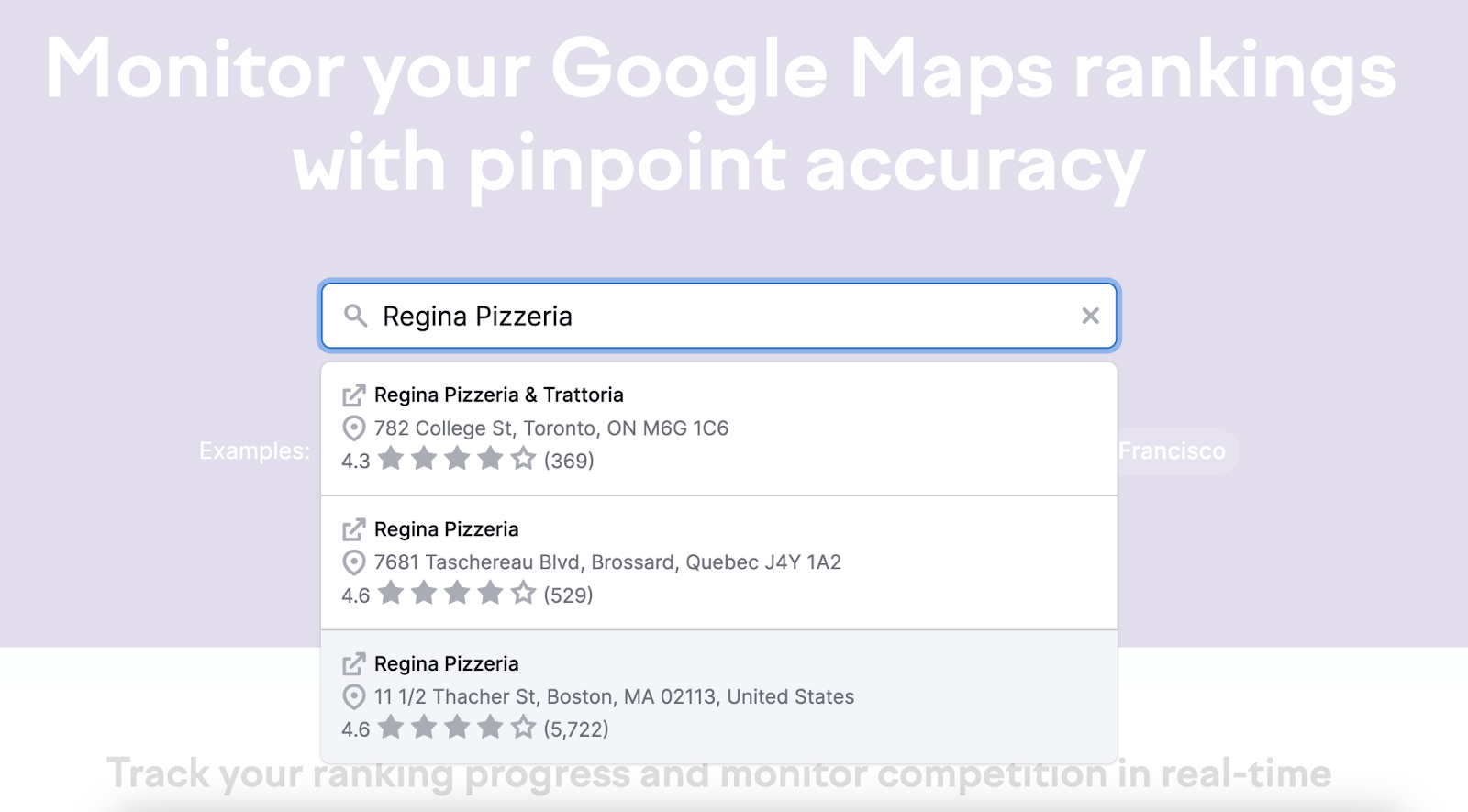
Then, choose the local keywords you’d like to track.
There are AI suggestions to help you.
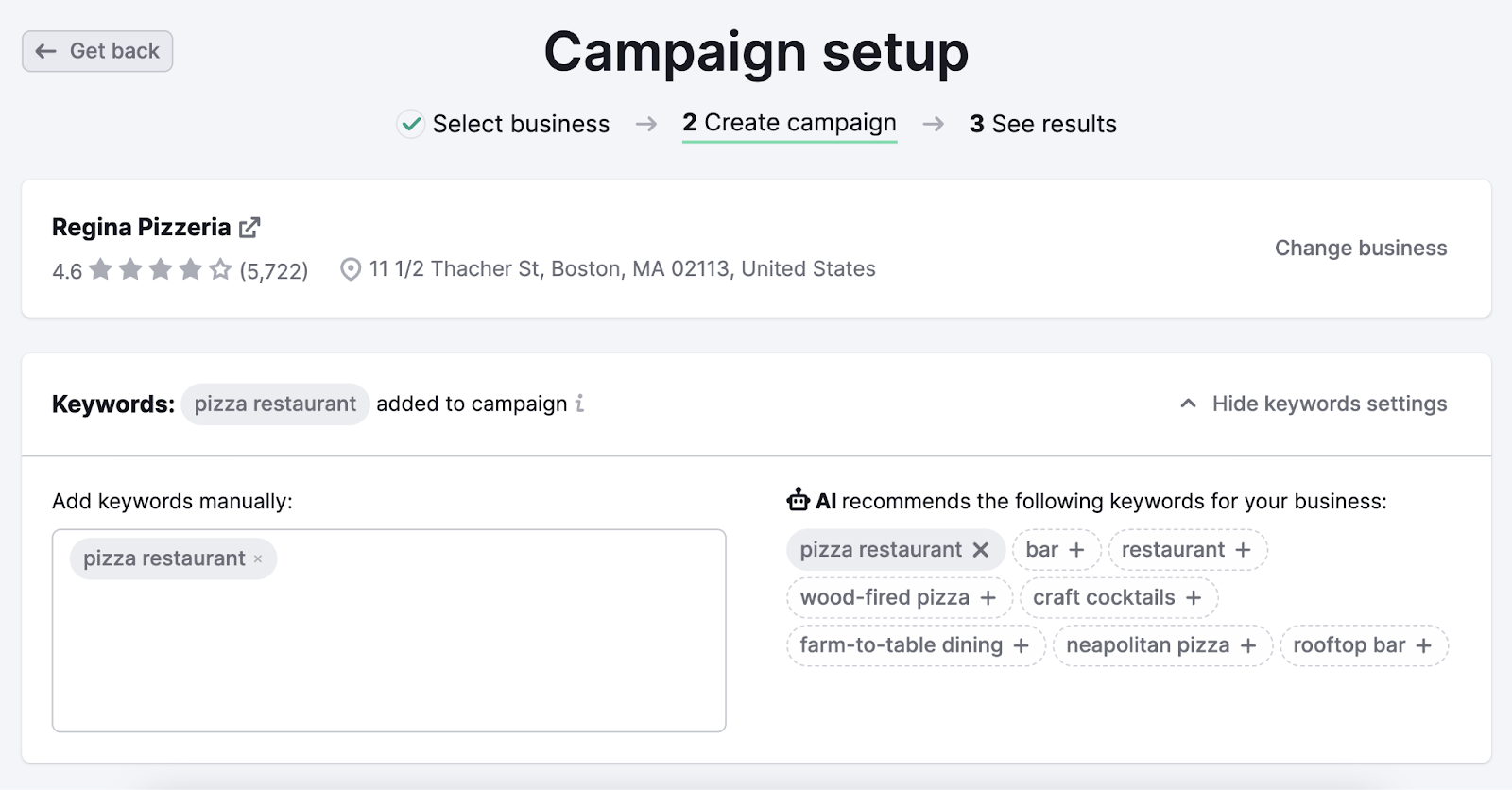
Next, you need to set your target location.
Each circle represents a search location that the tool will track your rankings in.
If you have lots of nearby competitors, it’s a good idea to go more granular. If your competitors are more widespread, you might want to cover a larger area.
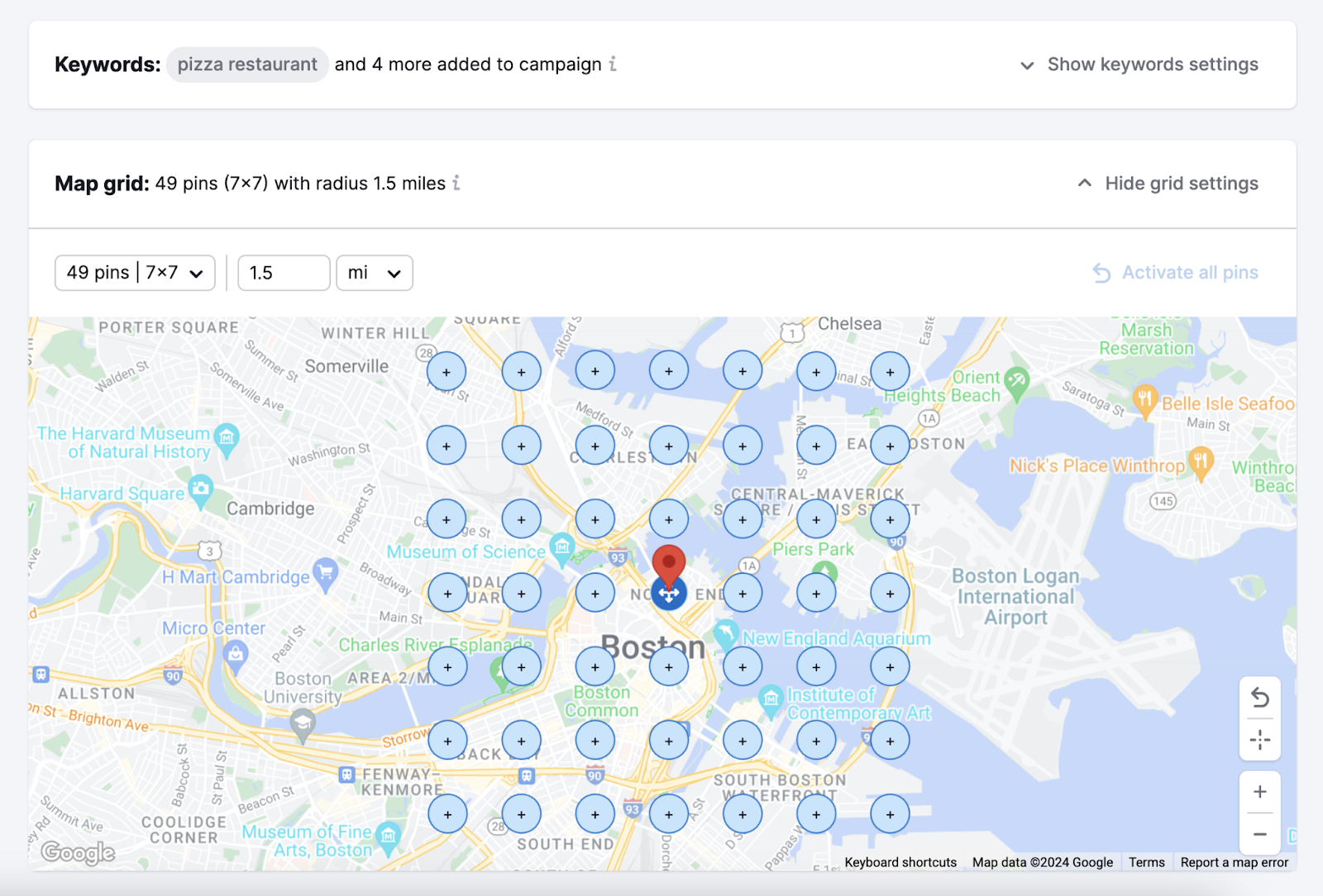
When setup is complete, choose a keyword you want to review from the drop-down at the top.
Then, the heatmap will show your business’s ranking in each search location.
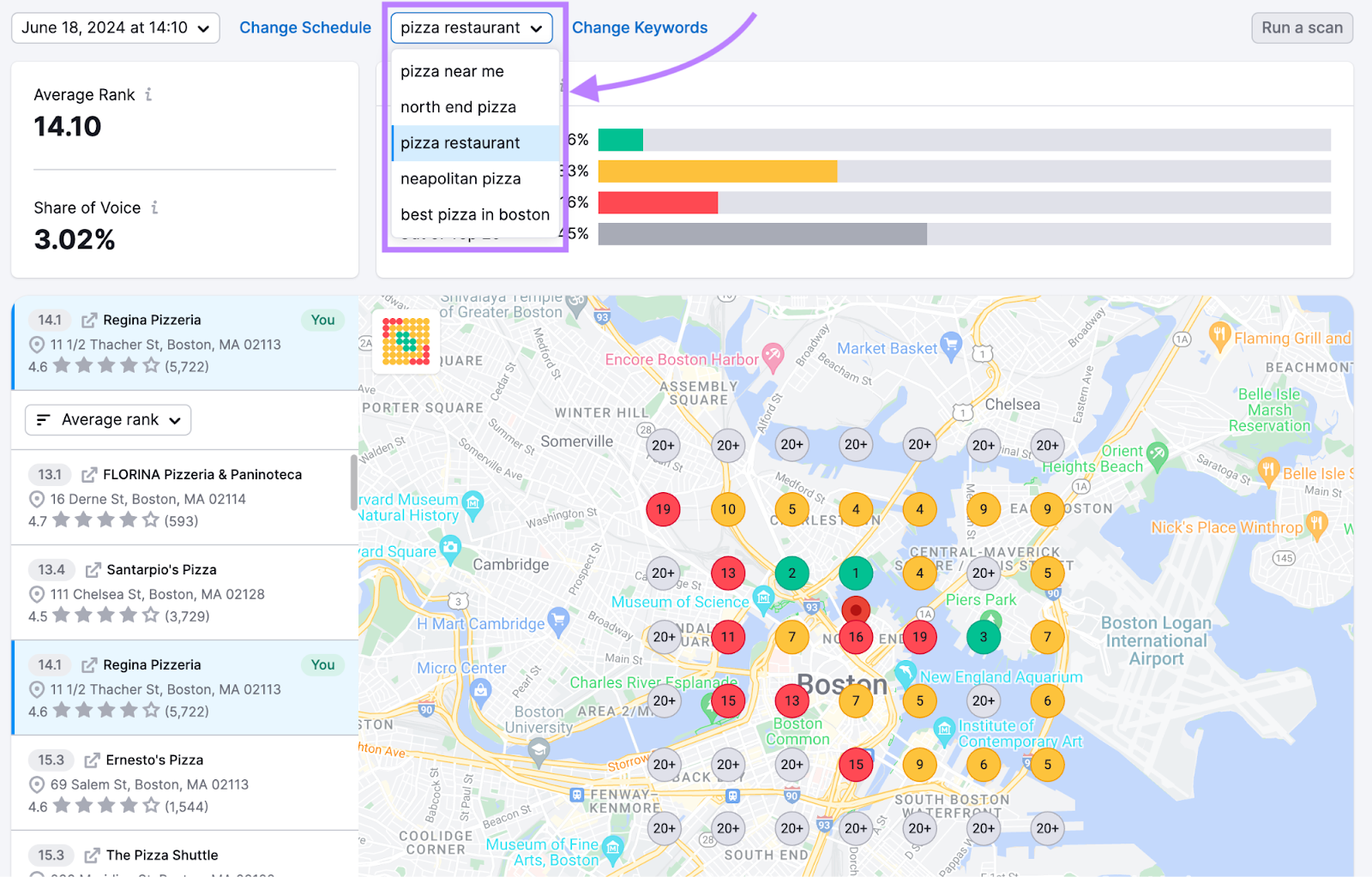
Click any numbered circle to see the search results for yourself. And check out your biggest competitors.
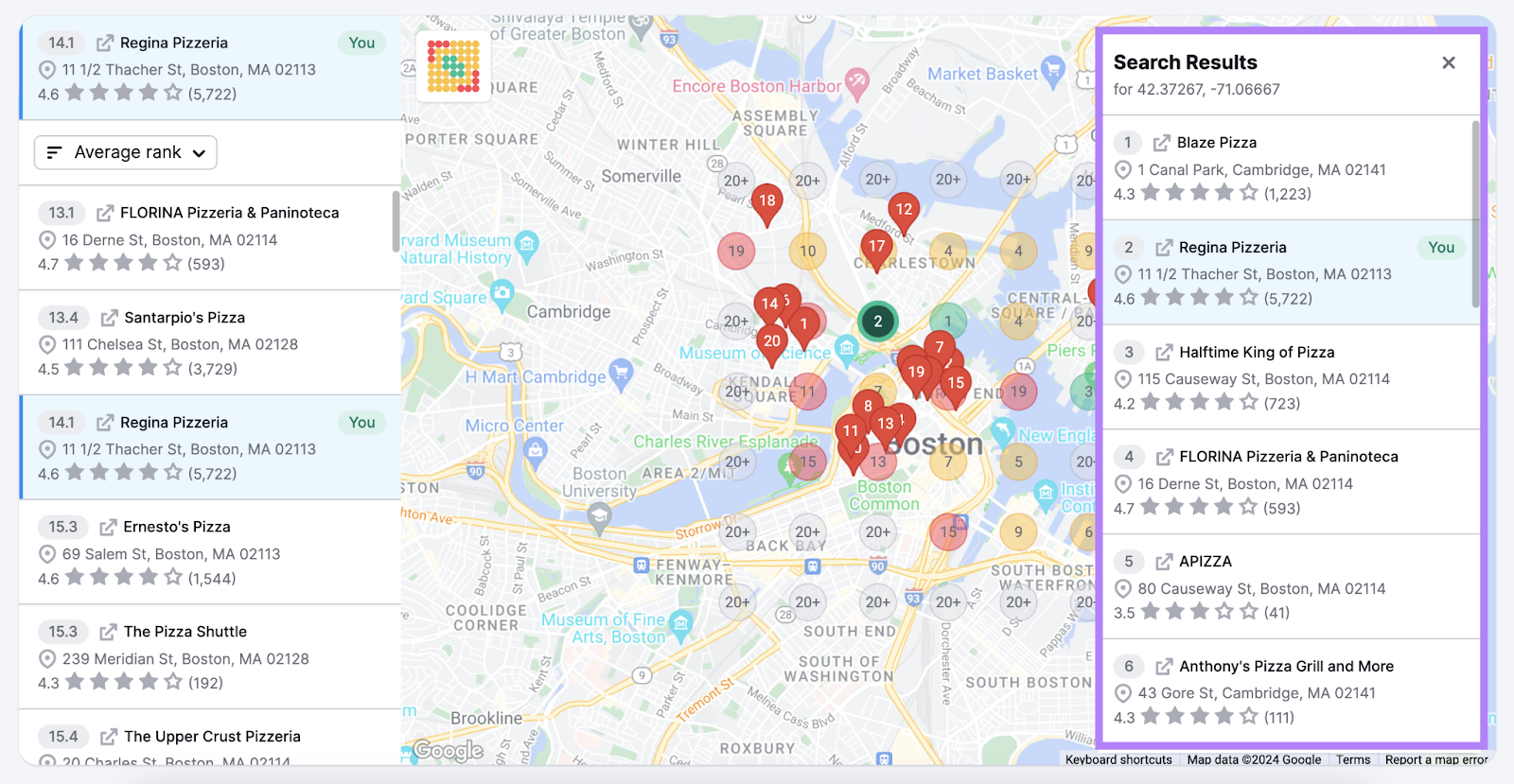
Track Your Local Rankings in Google Search
Semrush’s Position Tracking tool lets you monitor your rankings in Google Search. And you can check your performance in different countries, states, regions, cities, or zip codes.
During the setup process, make sure to specify your target location.
And input your business name as it appears in your Google Business Profile.
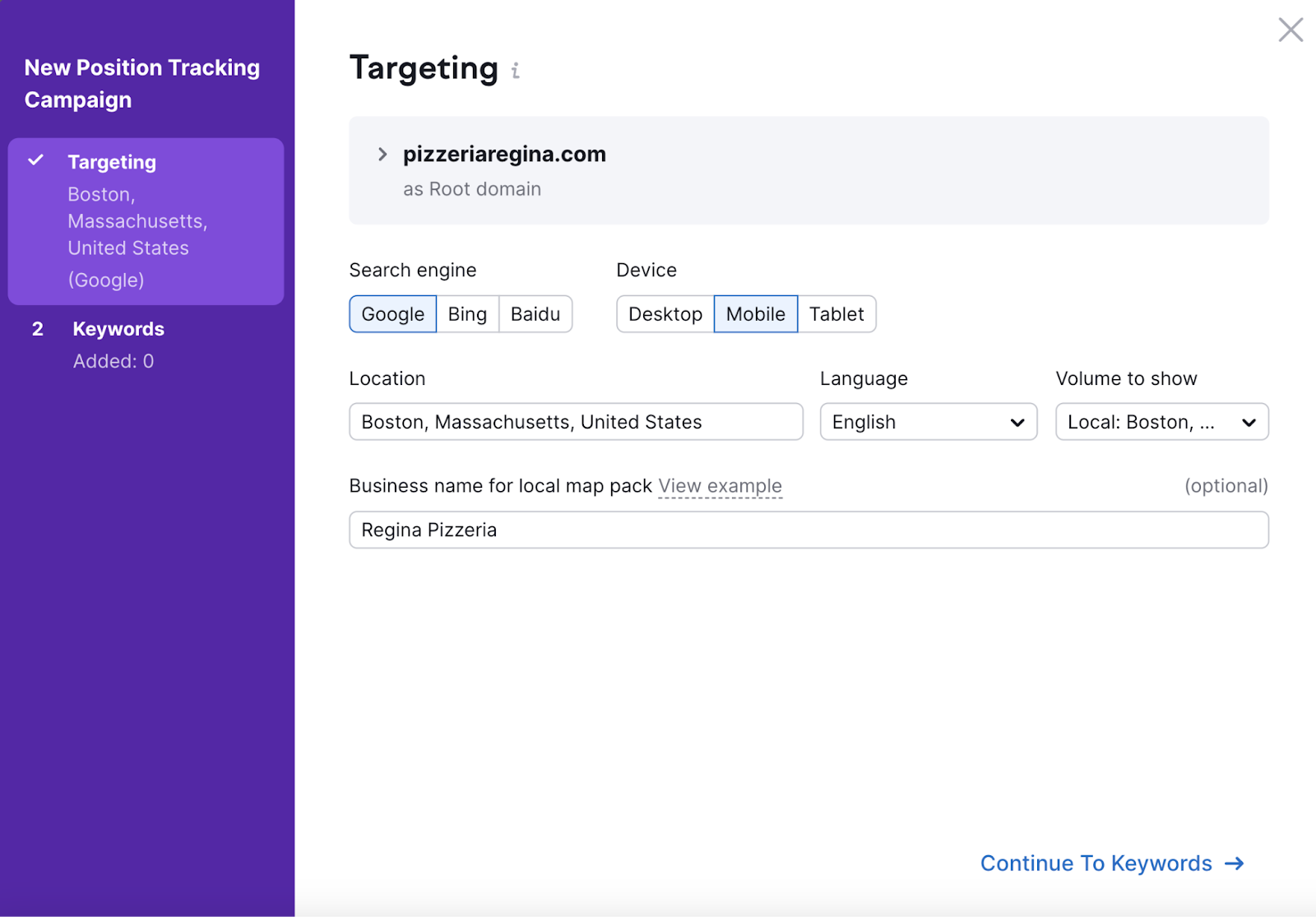
Then, import all the local keywords you want to rank for.
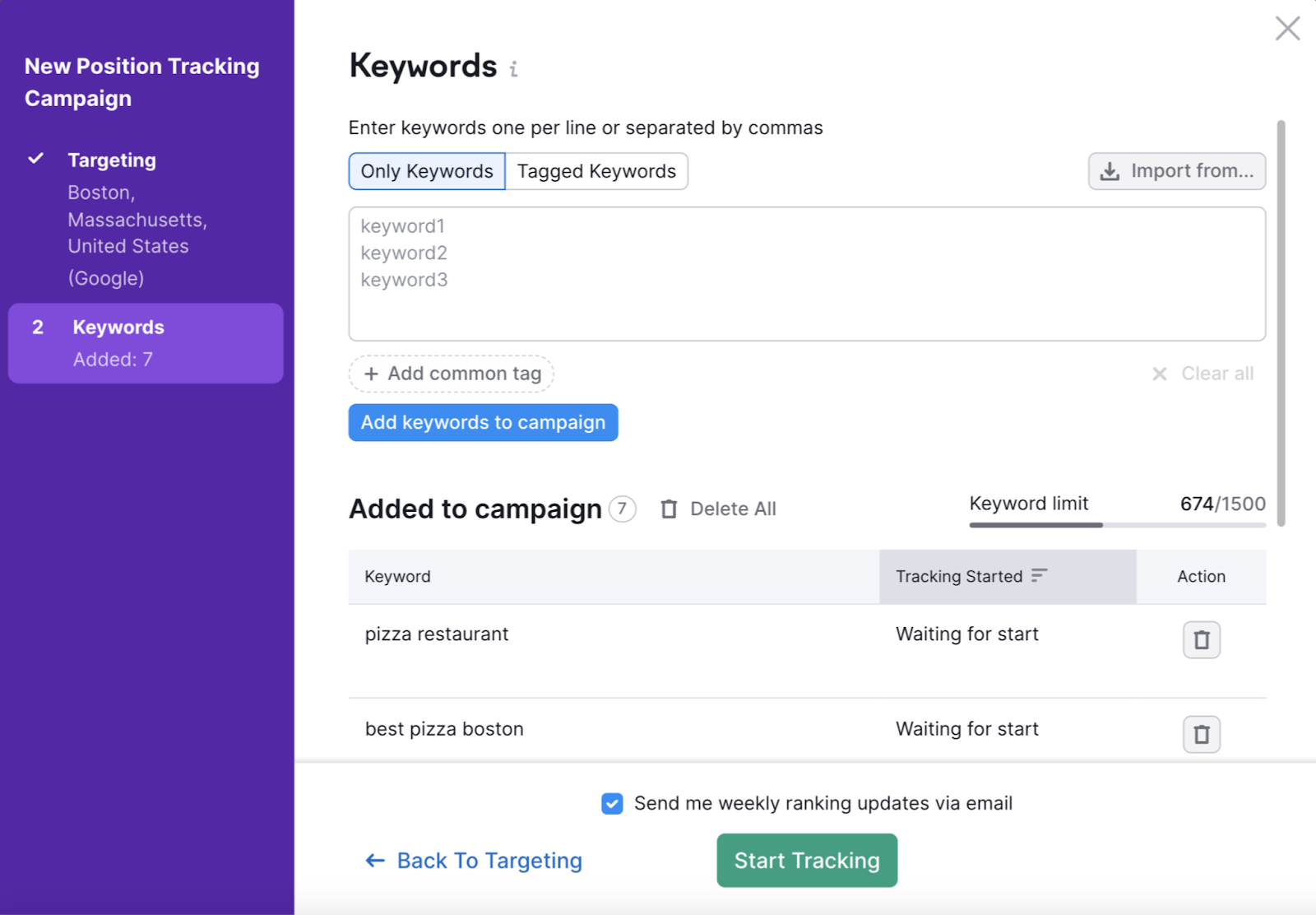
When your project is ready, head to the “Overview” report. And select the time range you’re interested in.
The graphs help you understand your overall performance.
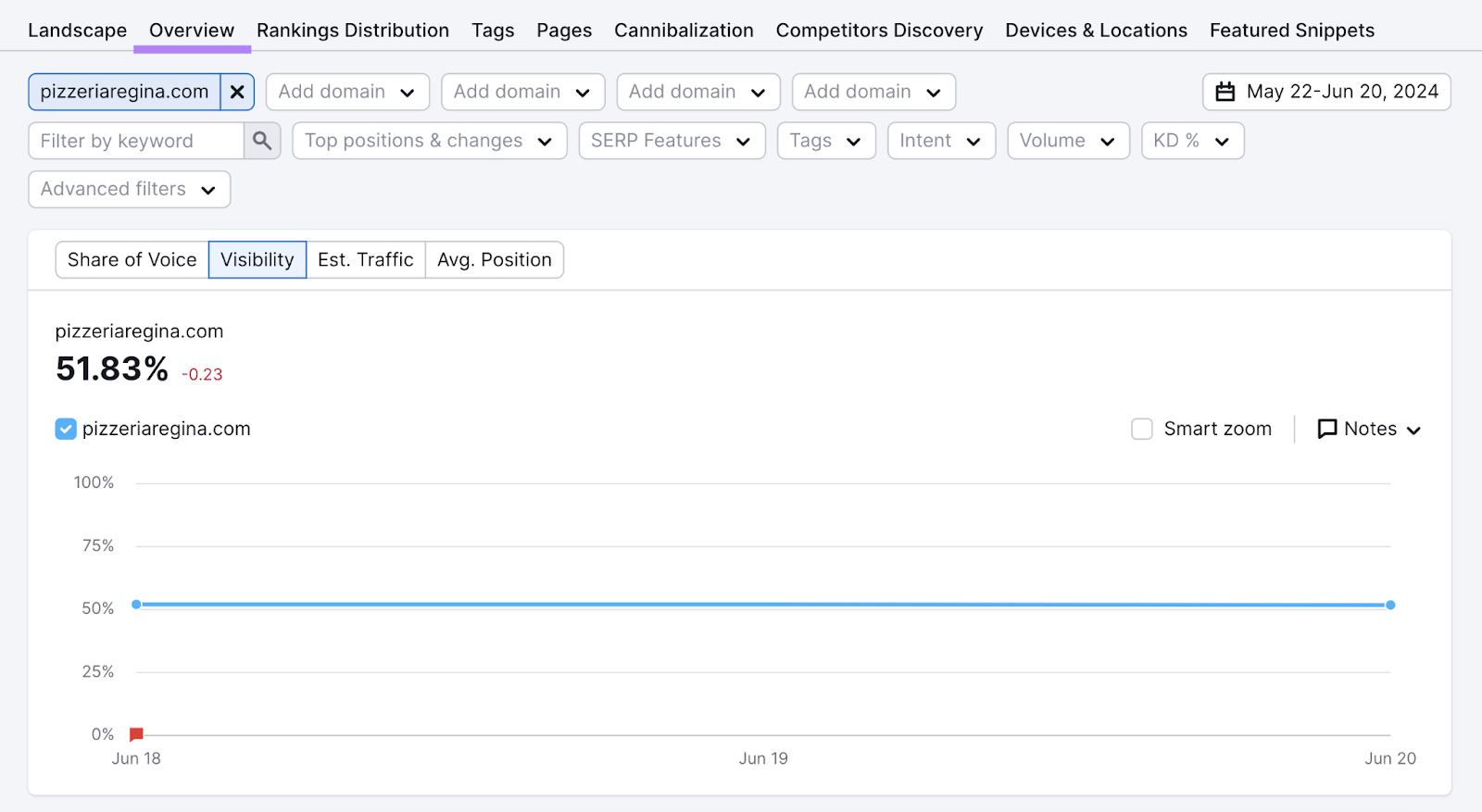
Scroll down to see your current and previous ranking position for each target keyword.
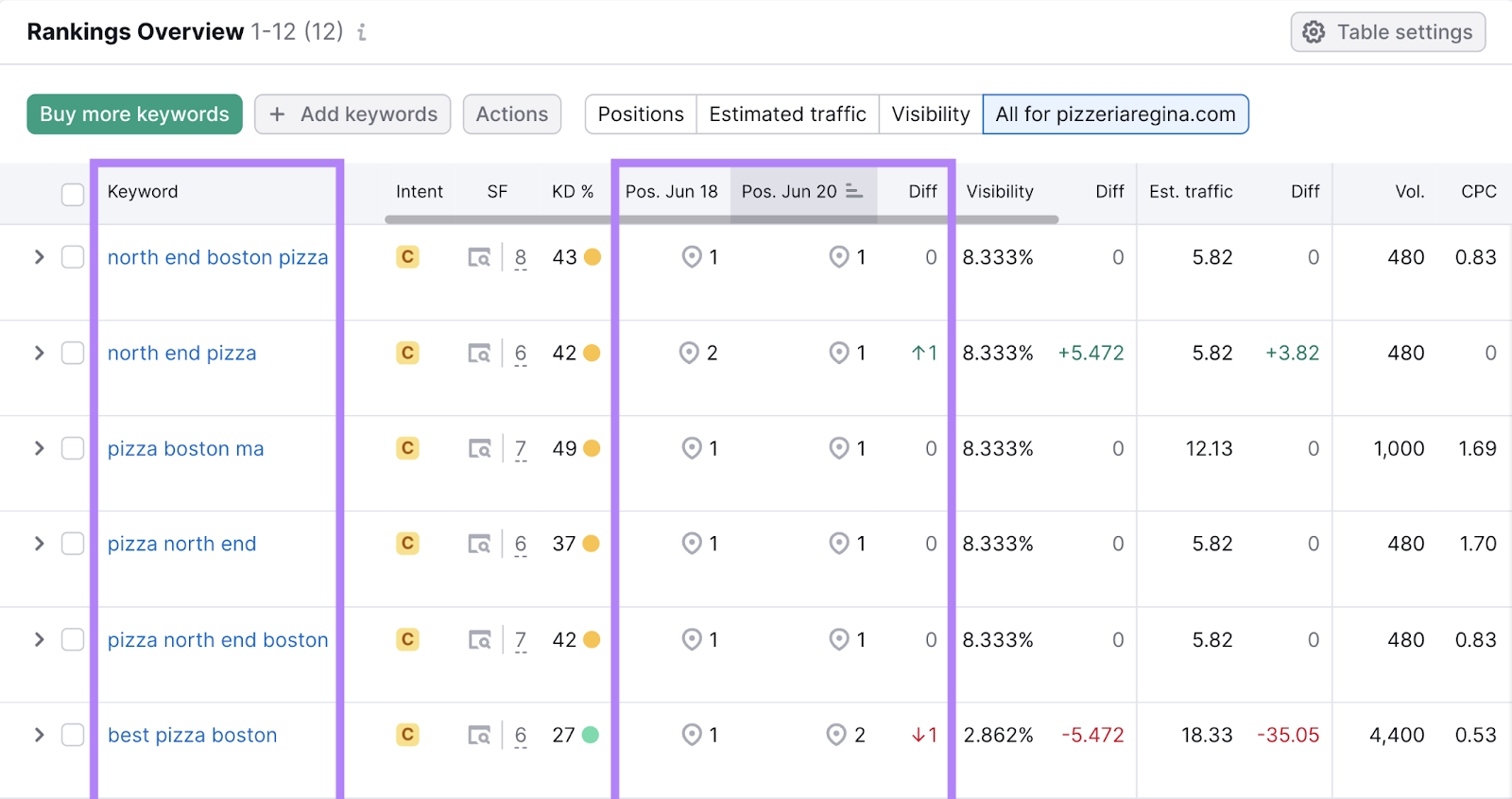
To see which keywords trigger a local pack, go to “SERP Features,” select the circle next to “Feature on SERP,” and choose “Local pack.”
Or use the “[domain] doesn't rank” option to discover local packs you’re missing out on.
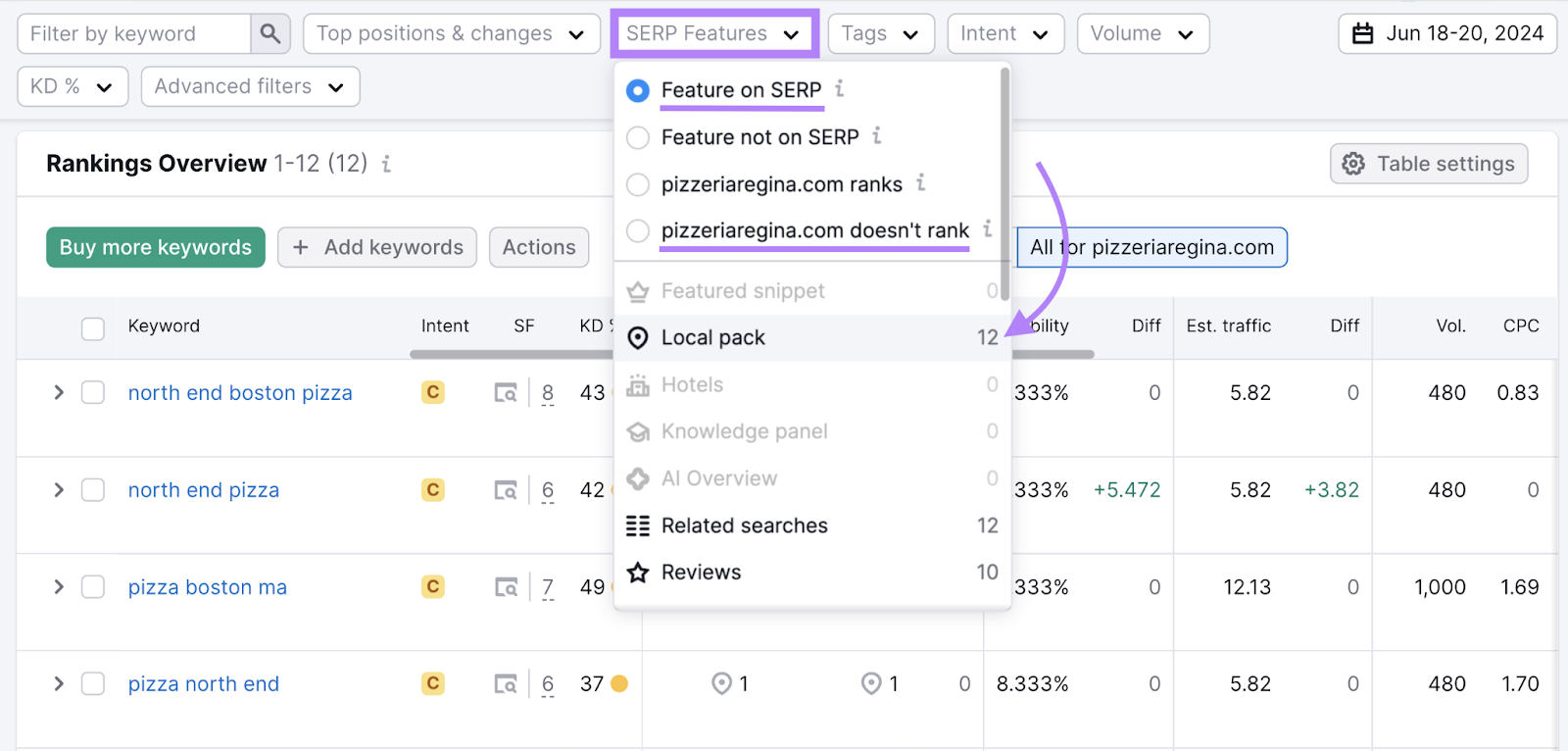
You can then update your local SEO strategy.
Start Building Your Local Visibility
With Semrush Local, it’s easy to start building your local search visibility.
A premium subscription costs $40 per month for each location. And gives you access to:
- Listing Management, which makes it easy to create and manage online listings
- Review Management, which helps you monitor your online reviews
- Map Rank Tracker, which allows you to track your Google Maps performance
